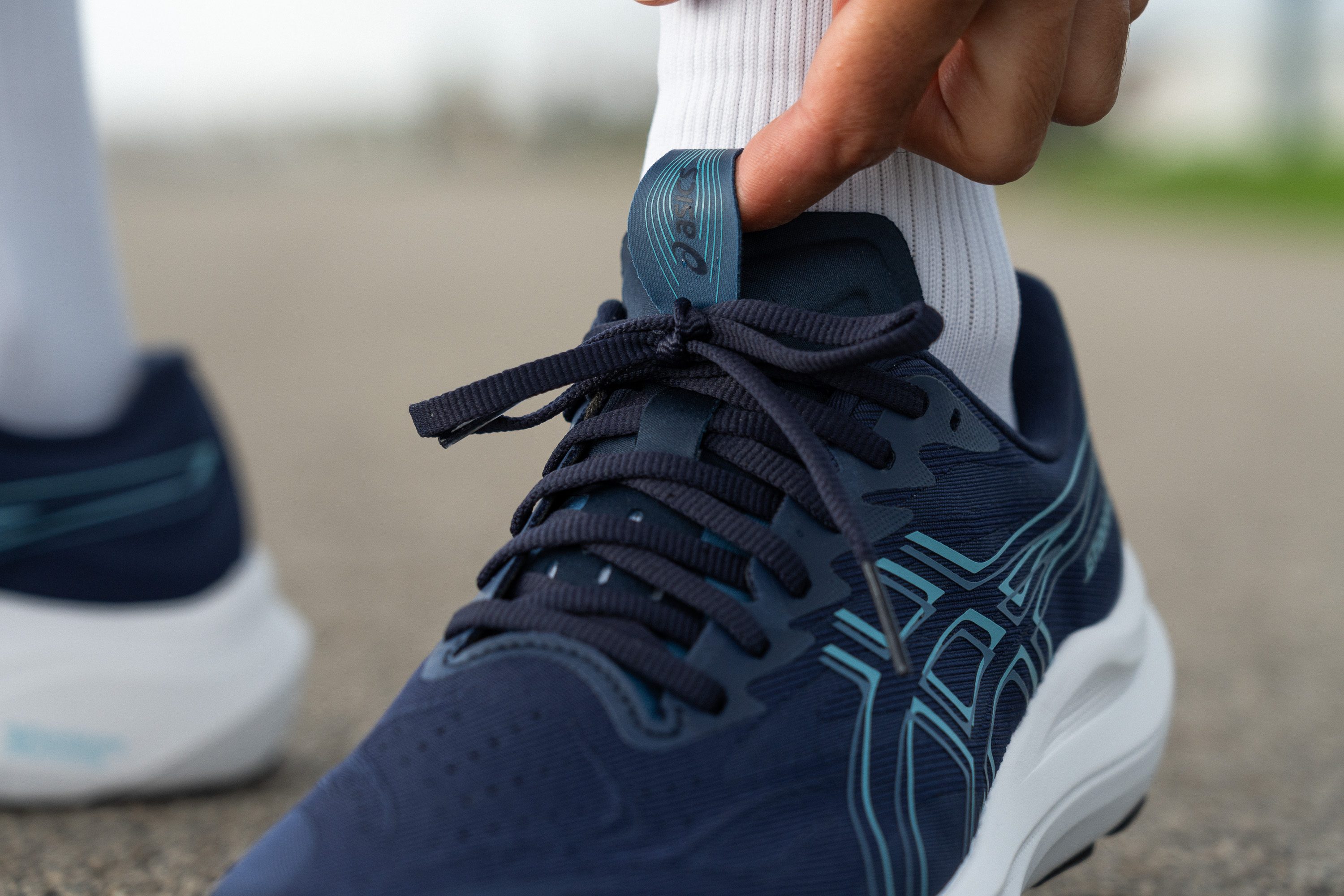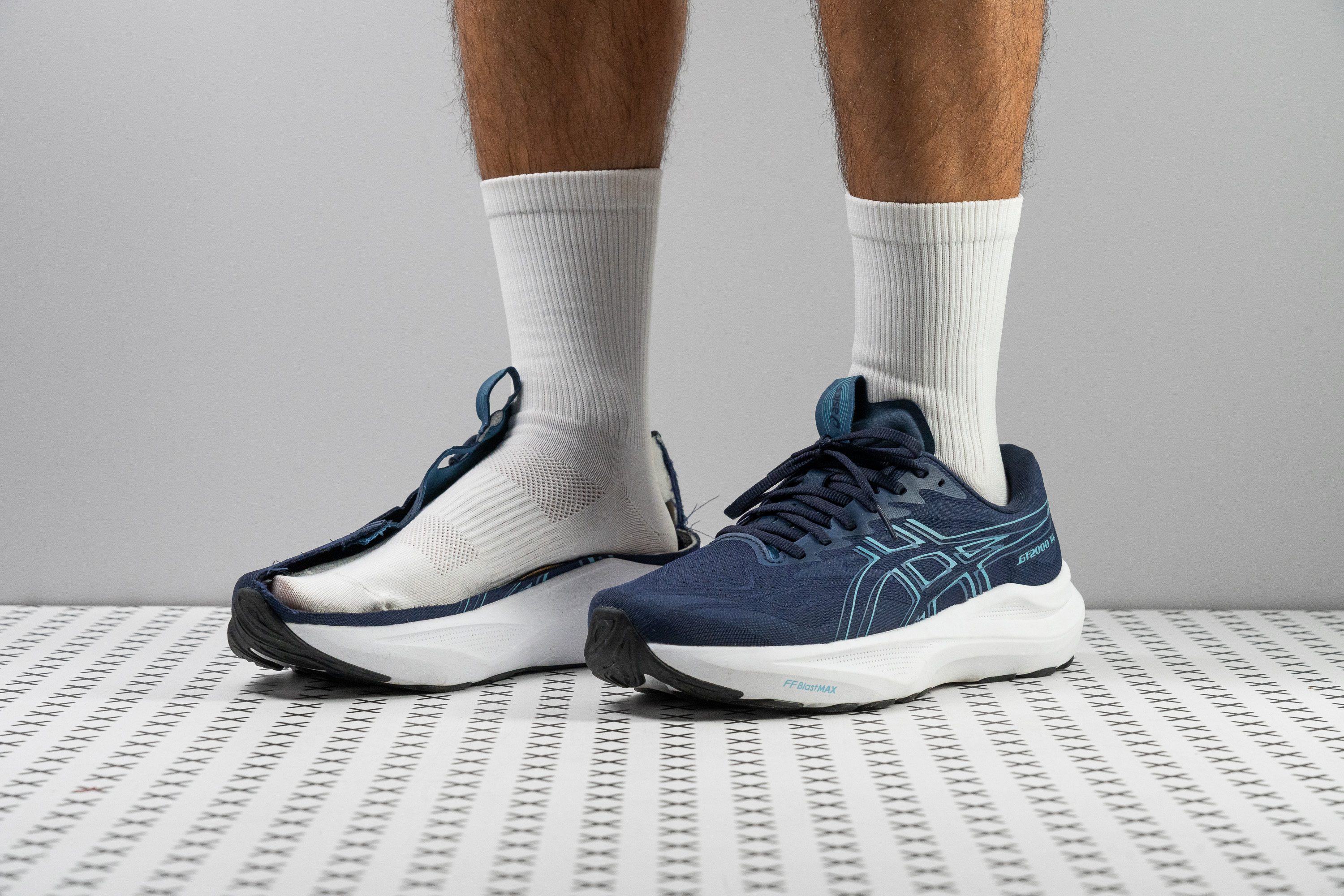Nuestra conclusión
Pros
- Espuma FF Blast Max mejorada
- La suela es muy duradera
- Diseño estable sin ser intrusivo
- Peso razonable
- Mismo precio incluso con las mejores
- Upper bien diseñado que ofrece sujeción
- El nuevo diseño de la suela exterior mejora la flexibilidad
- Tracción fiable
- Tracción fiable
Contras
- Poco transpirables
- La parte delantera se estrecha y te puede apretar
- Siguen sin tener una pisada que de verdad esté cargada de energía
- La tecnología PureGEL no hace mucho
Veredicto de los usuarios
- Top 1% entre zapatillas de running ASICS Gt 2000
- Top 18% más vendidas zapatillas de running
Comparativa
Las zapatillas de running más parecidas
+ + Añadir unas zapatillas | |||||
|---|---|---|---|---|---|
| Puntuación global | 82 Buenas | N/A | 81 Buenas | 85 Buenas | |
| Precio | 160 € | 190 € | 130 € | 160 € | |
| Pace | Correr a diario | Correr a diario | Correr a diario | Correr a diario | |
| Absorción de impactos | Alta | Moderada | Moderada | Moderada | |
| Retorno de energía | Moderado | Alto | Bajo | Moderado | |
| Tracción | Alta | Alta | Alta | Alta | |
| Arch support | Estabilidad | Estabilidad | Estabilidad | Estabilidad | |
| Peso laboratorio Peso marca | 9.5 oz / 269g 9.4 oz / 266g | 9.3 oz / 264g 9.5 oz / 269g | 9.6 oz / 272g 9.3 oz / 265g | 10.4 oz / 295g 10.5 oz / 298g | |
| Drop laboratorio Drop marca | 8.7 mm 8.0 mm | 10.1 mm 8.0 mm | 9.6 mm 8.0 mm | 9.3 mm 8.0 mm | |
| Técnica de carrera | TalónMedio/antepié | Talón | TalónMedio/antepié | TalónMedio/antepié | |
| Talla | Tallan bien | - | Tallan un poquito pequeño | Tallan un poquito pequeño | |
| Rigidez de la mediasuela | Blanda | Blanda | Blanda | Blanda | |
| Diferencia de la rigidez de la mediasuela en frío | Normal | Pequeña | Normal | Grande | |
| Durabilidad de la parte delantera | Decente | Decente | Decente | Decente | |
| Durabilidad del acolchado del talón | Alta | Media | Alta | Baja | |
| Durabilidad de la suela exterior | Buena | Buena | Buena | Decente | |
| Transpirabilidad | Baja | Baja | Baja | Media | |
| Anchura / ajuste | Media | Estrecha | Media | Media | |
| Anchura de la parte delantera | Estrecha | Estrecha | Media | Media | |
| Flexibilidad | Moderada | Moderada | Moderada | Moderada | |
| Rigidez torsional | Rígidas | Rígidas | Rígidas | Moderadas | |
| Rigidez del contrafuerte del talón | Rígido | Rígido | Moderado | Rígido | |
| Talón laboratorio Talón marca | 36.9 mm 36.5 mm | 36.8 mm 33.0 mm | 35.4 mm 34.5 mm | 36.8 mm 38.0 mm | |
| Antepié laboratorio Antepié marca | 28.2 mm 28.5 mm | 26.7 mm 25.0 mm | 25.8 mm 26.5 mm | 27.5 mm 30.0 mm | |
| Anchuras disponibles | EstándarAnchoExtra Ancho | Estándar | EstándarAnchoExtra Ancho | EstrechoEstándarAnchoExtra Ancho | |
| Orthotic friendly | ✓ | ✓ | ✓ | ✓ | |
| Estación | Todas las estaciones | Todas las estaciones | Todas las estaciones | Todas las estaciones | |
| Removable insole | ✓ | ✓ | ✓ | ✓ | |
| Clasificación | #279 25% inferior | #201 46% inferior | #308 17% inferior | #213 42% inferior | |
| Popularidad | #66 Top 18% | #138 Top 37% | #153 Top 42% | #32 Top 9% |
Quién debería comprárselas
En nuestra opinión, las ASICS GT 2000 14 son una opción estupenda si:
- Tienes los pies estrechos y quieres unas zapatillas de entrenamiento diario que se sientan estables en cada paso.
- No te gustó que la espuma FF Blast+ de las versiones anteriores de las GT 2000 fuese tan plana; la nueva FF Blast Max mejora mucho la experiencia bajo los pies.
- Necesitas un modelo que ofrezca sujeción, que tenga una suela con una durabilidad excelente y que sea lo suficientemente versátil para el uso diario.
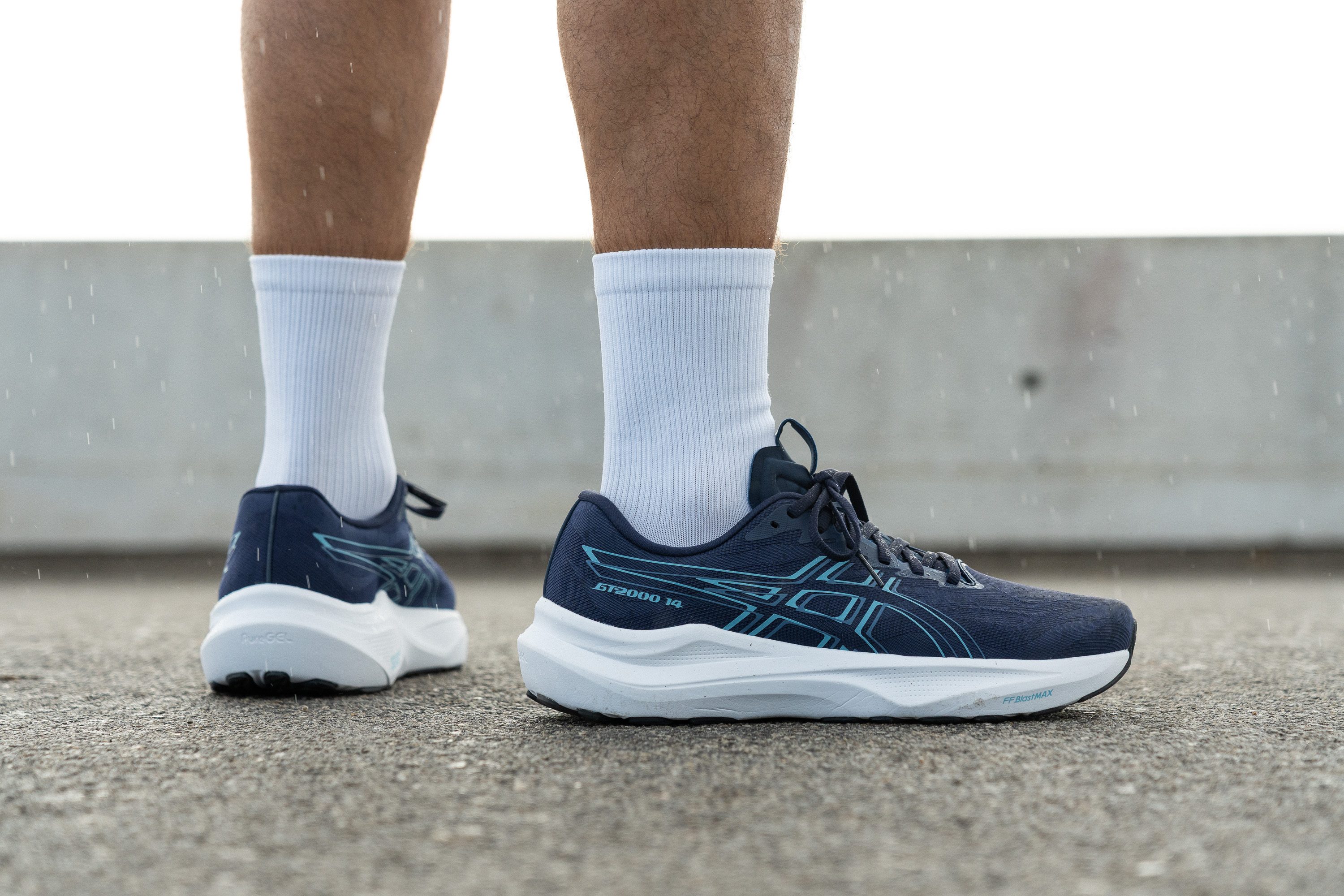
Quién NO debería comprárselas
Creemos que las ASICS GT 2000 14 no son la mejor opción ni para los corredores más pesados ni para los runners que están buscando la máxima amortiguación bajo los pies. En nuestra experiencia, este diseño es bastante modesto para los estándares actuales (sobre todo para los corredores de metatarsos o los deportistas más grandotes), así que recomendamos las ASICS Gel Kayano 32 como una alternativa más amortiguada.
Además, creemos que la parte delantera estrecha de este modelo podría echar para atrás a algunos compradores. Después de hacerle pruebas en nuestro laboratorio, descubrimos que es un poco restrictivo, así que no nos parece la mejor opción para nadie que necesite más espacio para estirar los dedos. Si estás buscando un ajuste más espacioso, te recomendamos las Altra Experience Form o las Adidas Supernova Solution.
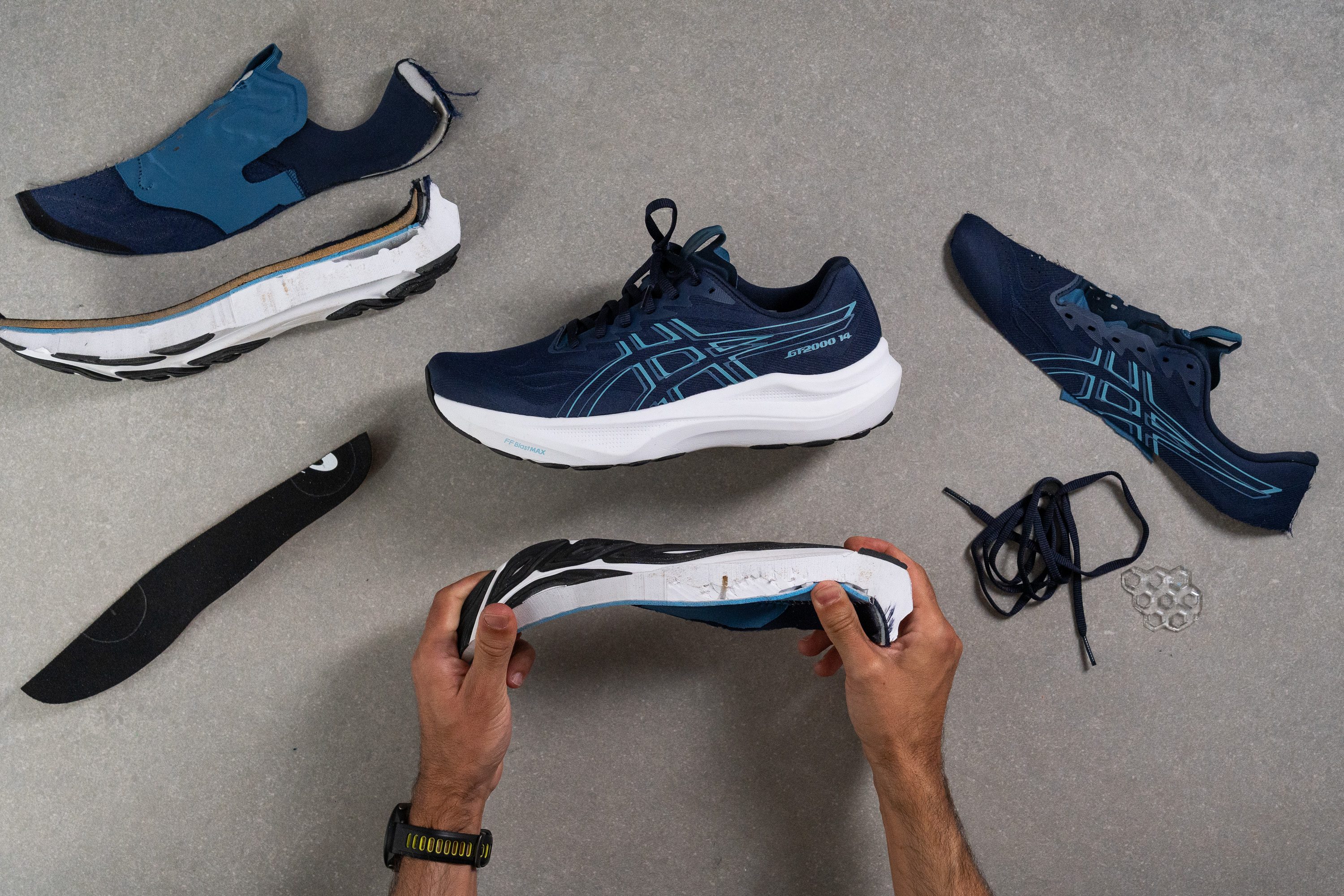
Amortiguación
Shock absorption
Pasar de la espuma FF Blast+ a la FF Blast Max hace que la absorción de impactos mejore (tal y como vimos en las Novablast 5), manteniendo al mismo tiempo una mediasuela con una altura razonable.
En nuestra prueba de laboratorio, el resultado fue de 132 SA en el talón y 110 SA en el antepié. Este diseño ofrece una pisada suave pero protectora, manteniendo a su vez una buena conexión con el suelo. Esto hace que sean más cómodas para las distancias largas y les ofrece más protección a los talonadores en comparación con las ediciones anteriores.
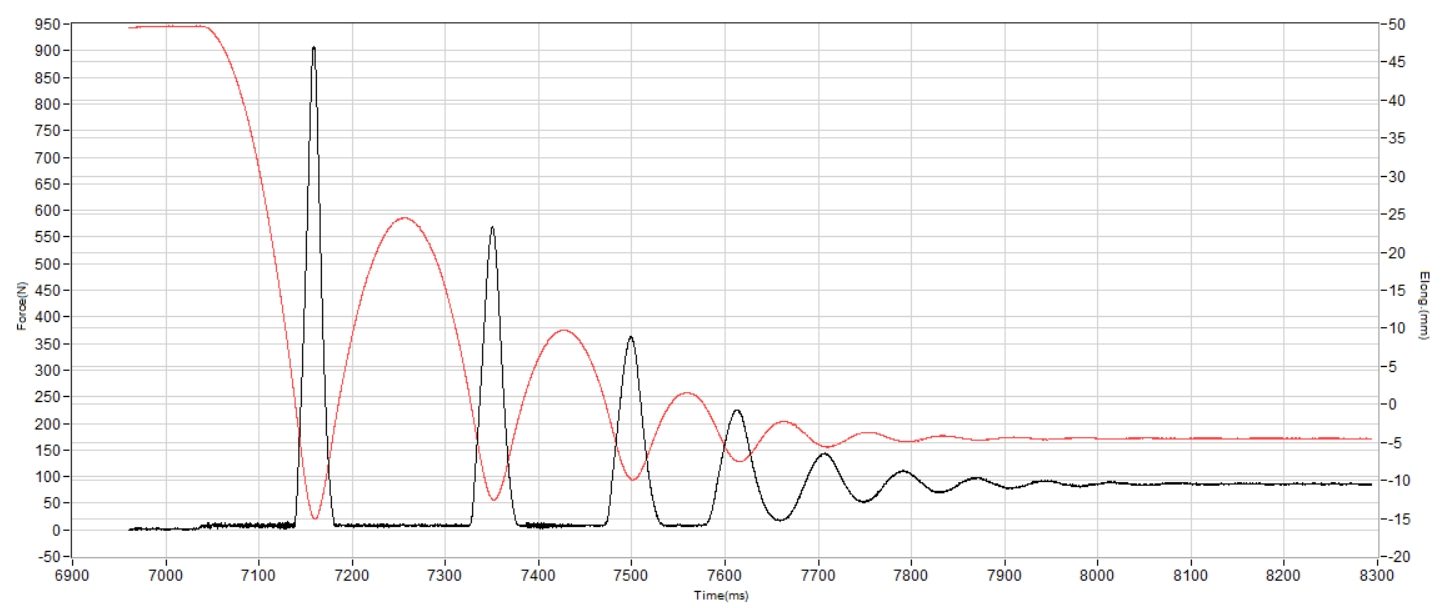
| GT 2000 14 | 132 SA |
| Media | 129 SA |
Energy return
Cuando analizamos las GT 2000 13 aquí en el laboratorio, descubrimos que su retorno de energía es bajísimo. Este detalle tan negativo es muy decisivo para cualquier deportista que se quiera centrar en el rendimiento.
Al utilizar la espuma FF Blast Max, el retorno de energía aumentó bastante: hasta un 56,0 % en el talón y un 57,2 % en el antepié. Siguen siendo resultados estándar, nada muy loco, pero bueno, ¡ya no son decepcionantes!
| GT 2000 14 | 56.0% |
| Media | 58.5% |
Altura de la suela en la zona del talón
ASICS dice que la suela de estas zapatillas en el talón mide 36,5 mm, y a nosotros nos dio prácticamente lo mismo: 36,9 mm. Es una altura perfecta para las GT 2000, ya que se alejan del territorio maximalista pero, incluso así, ofrecen un montón de amortiguación para salir a correr y cuidar de tus articulaciones y músculos.
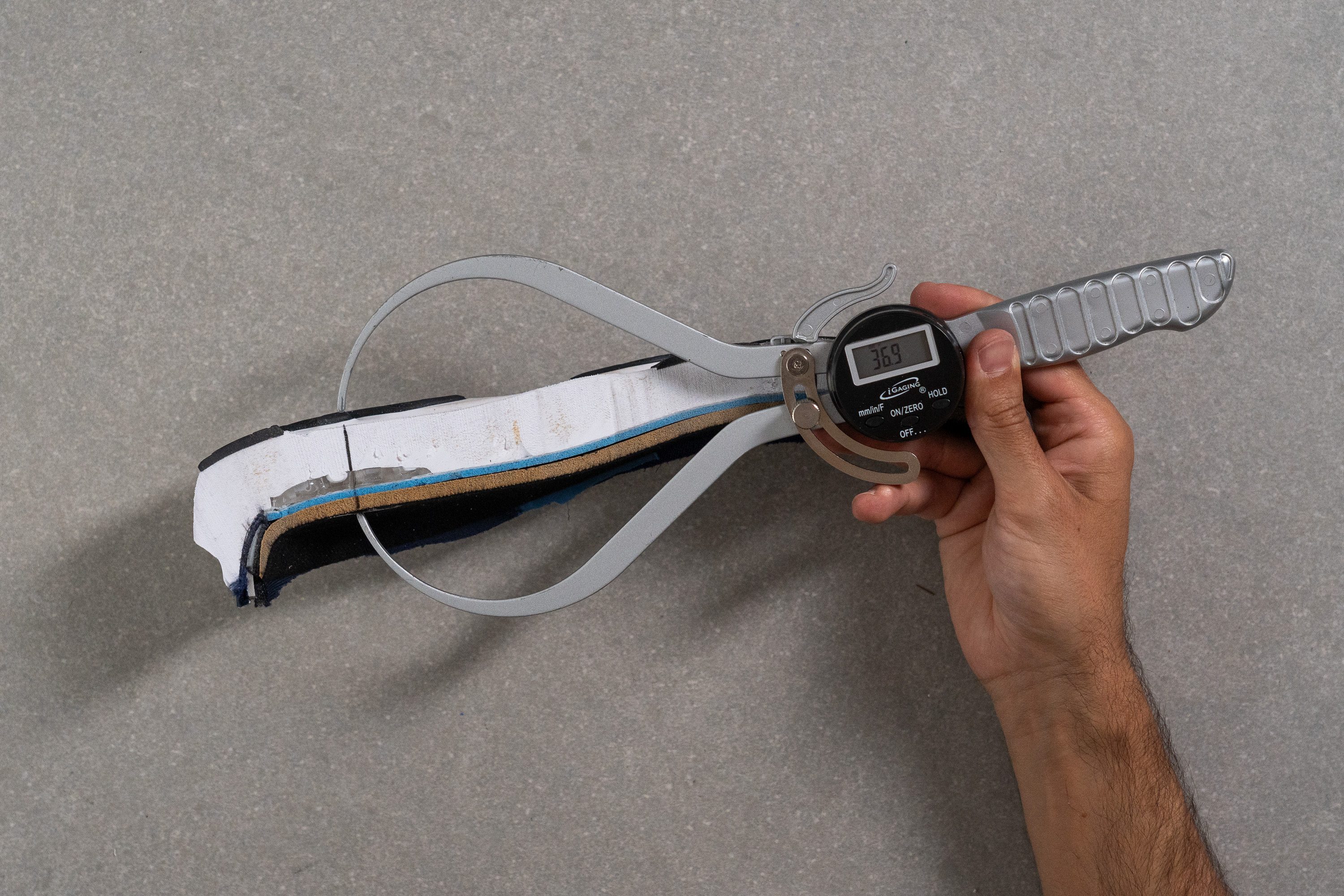
| GT 2000 14 | 36.9 mm |
| Media | 34.8 mm |
Altura de la suela en el antepié
Cuando medimos su altura en el antepié, nos dio 28,2 mm, así que creemos que se adaptan bien a los corredores de mediopié y de metatarsos. Este diseño también hace que estas ASICS sean una opción confiable para los entrenamientos de larga distancia.
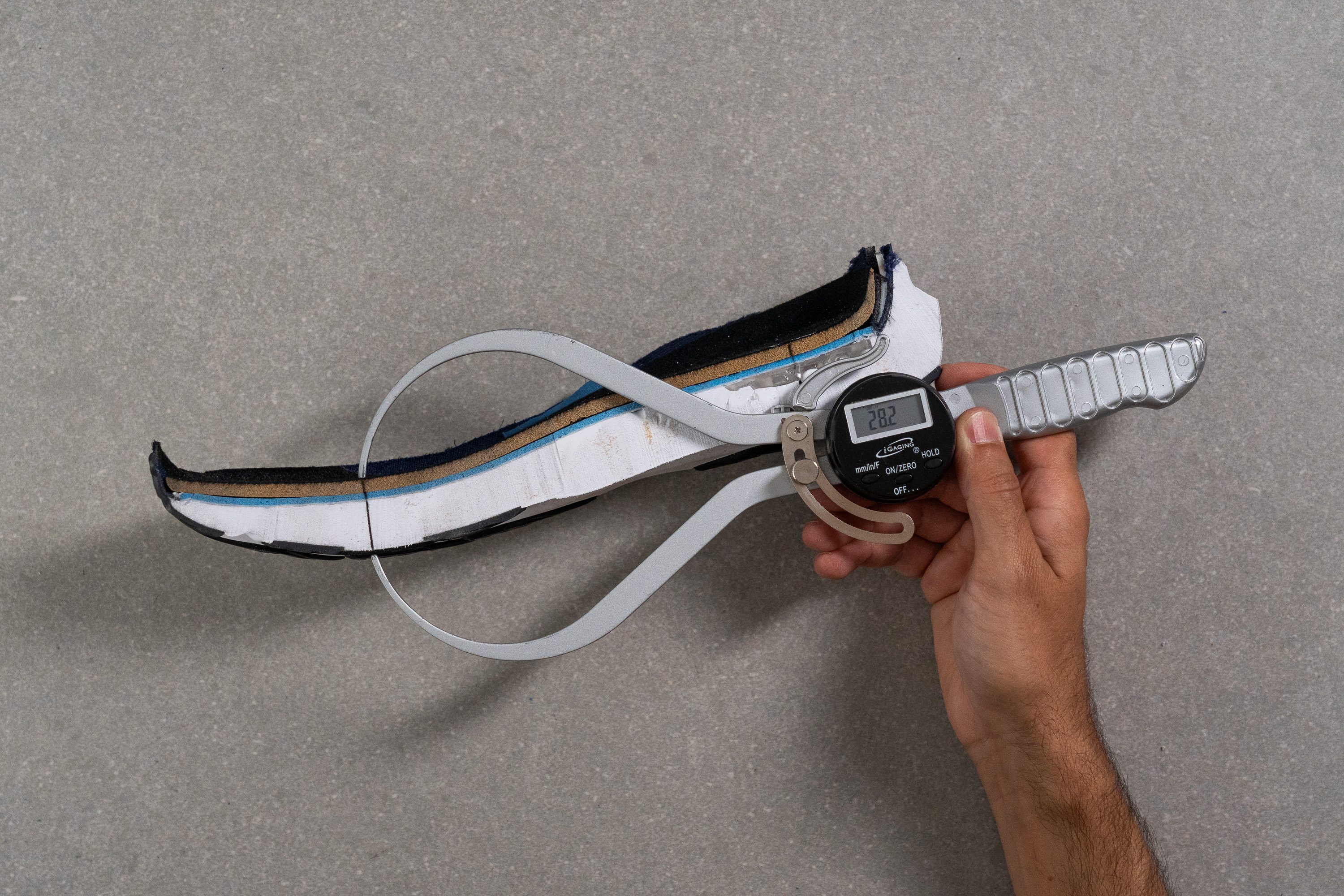
| GT 2000 14 | 28.2 mm |
| Media | 26.2 mm |
Drop
La serie GT 2000 ha tenido siempre un drop de 8 mm, y a diferencia de muchas de las zapatillas que analizamos, los resultados de nuestro calibre están bastante cerca de esa cifra.
Cuando analizamos las GT 2000 14, nuestro calibre marcó 8,7 mm siguendo las normas de la World Athletics. Esto confirma que son versátiles para las distintas técnicas de carrera sin ser demasiado agresivas.
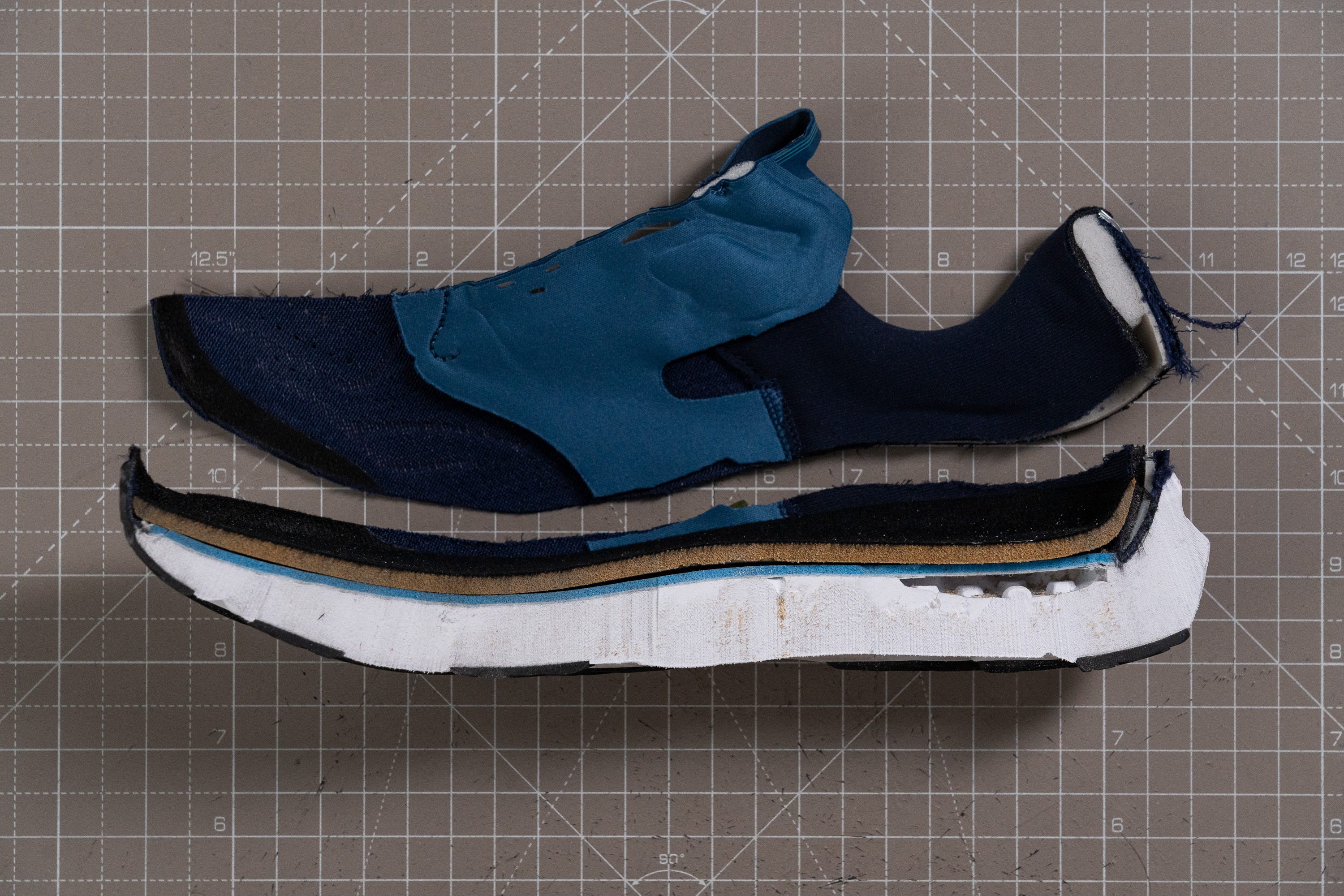
| GT 2000 14 | 8.7 mm |
| Media | 8.6 mm |
Suavidad de la mediasuela
Al pasar de la espuma FF Blast+ a la FF Blast Max, la mediasuela se siente un poquito más blanda que antes. Pero bueno, no te esperes una sensación parecida a estar corriendo sobre las nubes, ya que estamos hablando de unas zapatillas de estabilidad, y al final que sean demasiado mullidas pondría en riesgo su propósito.
Después de analizarlas 4 veces, hicimos una media de sus resultados, y nos dio 17,4 HA. En nuestra opinión, es una elección muy inteligente, ya que ASICS evita que se sientan tan rígidas como muchos modelos de estabilidad, que es algo que podría ser un poco raro para un modelo que ha salido en 2025.
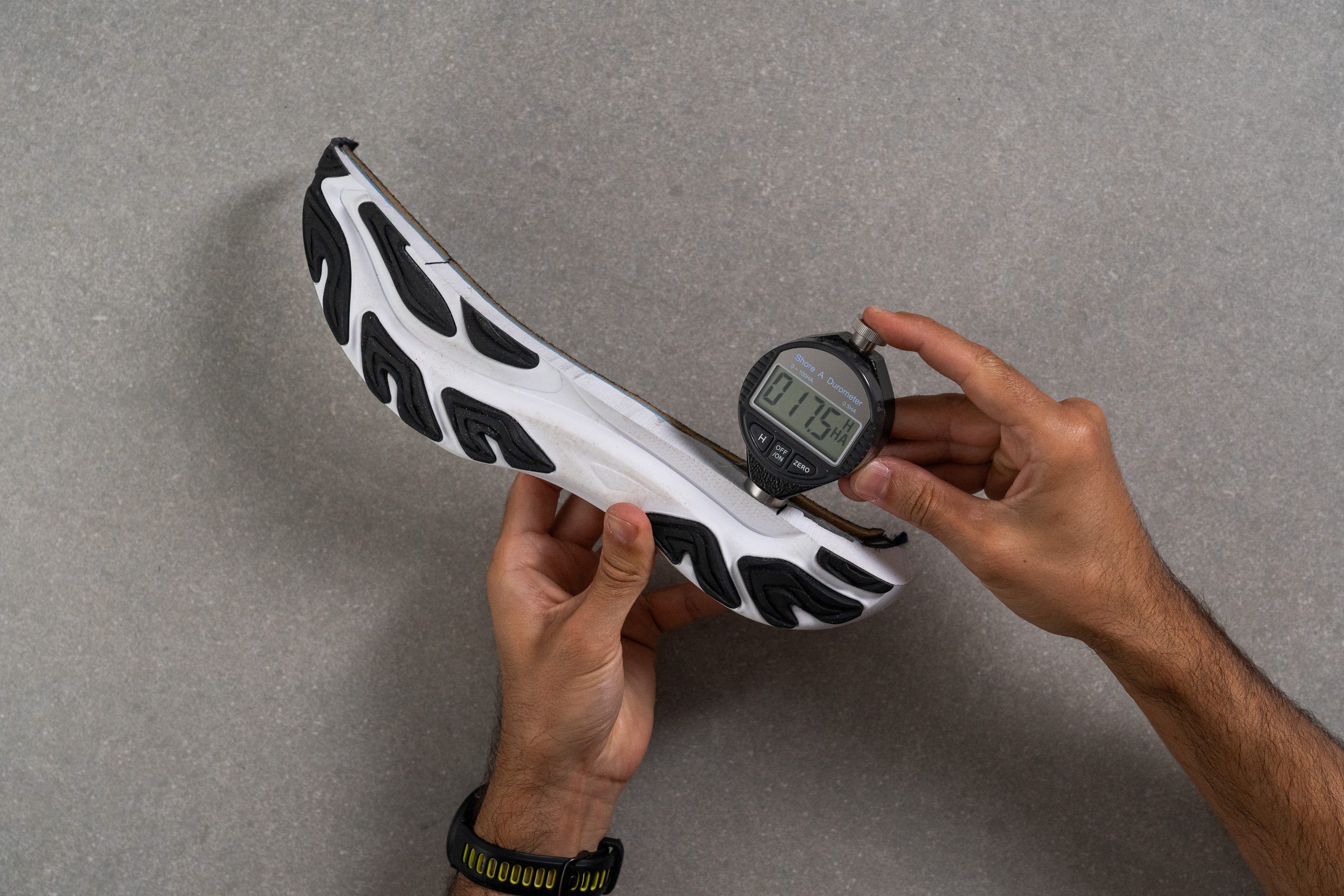
| GT 2000 14 | 17.4 HA |
| Media | 20.4 HA |
Rocker
El rocker de las GT 2000 14 tiene un diseño clásico en el talón con una curva suave y discreta, así que los corredores no deberían esperarse mucha ayuda por su parte en las transiciones. Esto hace que los talonadores disfruten de una sensación natural, sin ningún tipo de diseño agresivo y manteniendo una geometría estable y conocida.
En el antepié, el rocker también se activa gradualmente con una curva ascendente muy suave, lo que hace que los despegues sean naturales y que el contacto con el suelo sea bueno, evitando una sensación demasiado rígida.
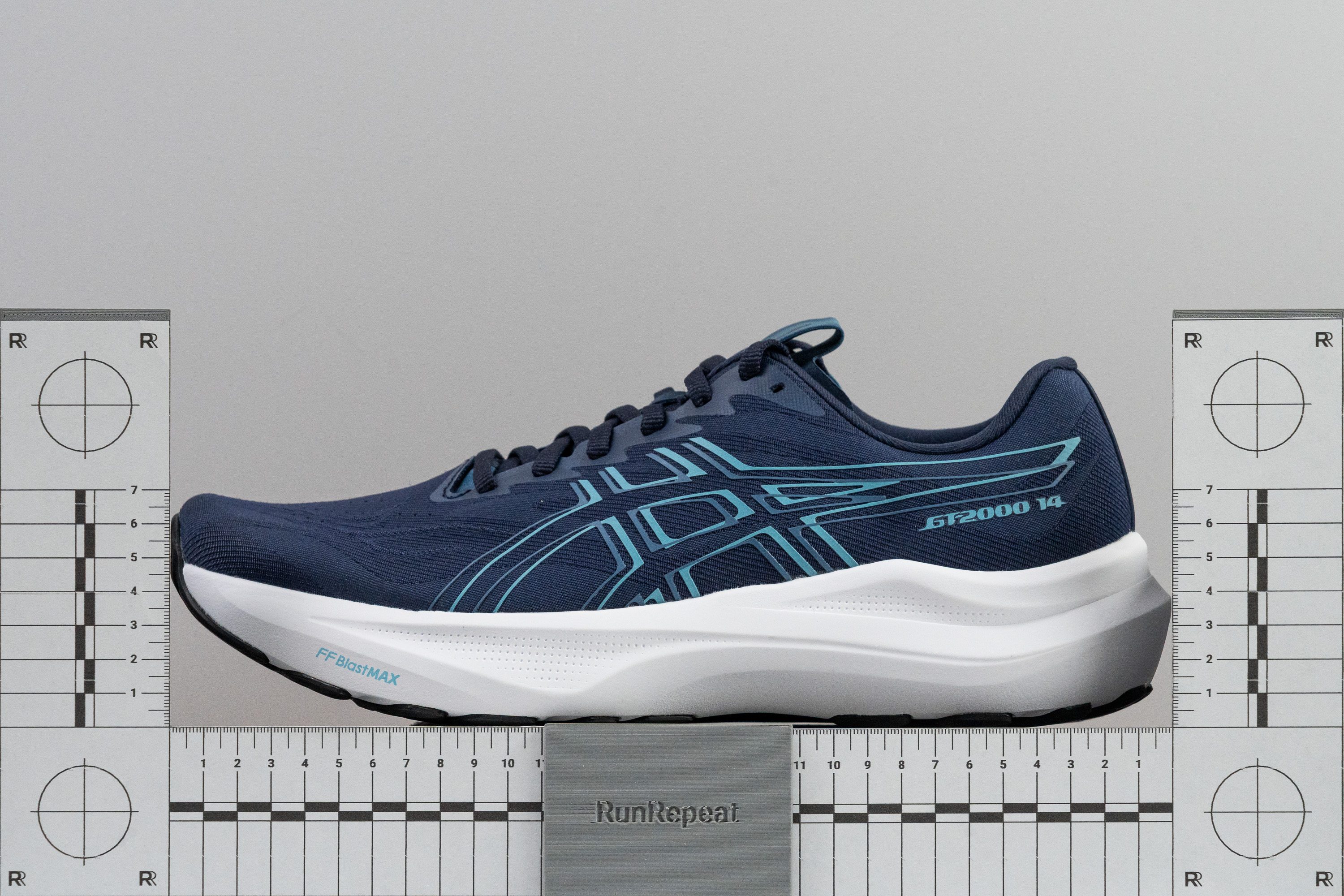
PureGEL
Las GT 2000 14 siguen teniendo la pieza PureGEL en el talón, pero... no estamos muy seguros de que aporte demasiado. Aunque suaviza los aterrizajes, el peso extra y el poco rebote hacen que no merezca la pena.
Así que, sí, ¡a lo mejor va siendo hora de avanzar, ASICS!
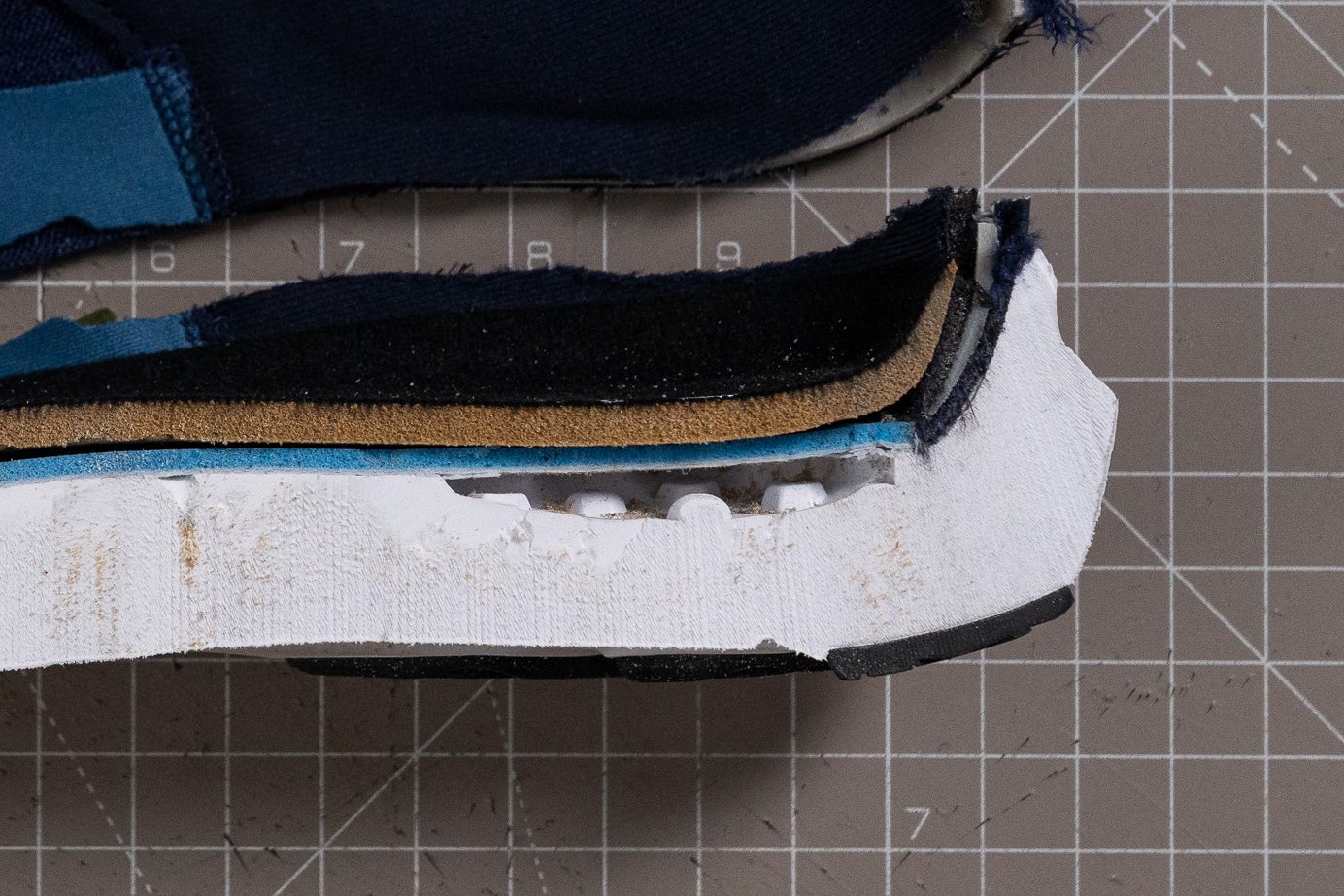
Tallaje y ajuste
Talla
Las ASICS GT 2000 14 tallan bien (25 votos).
Anchura / Ajuste
Analizamos el interior de las GT 2000 14 con un molde de gel para saber más sobre su ajuste y poder compararlo con el de otros modelos de running.
Resulta que su anchura es de 94,5 mm, que es un poco menos que la media, aunque se acerca bastante.
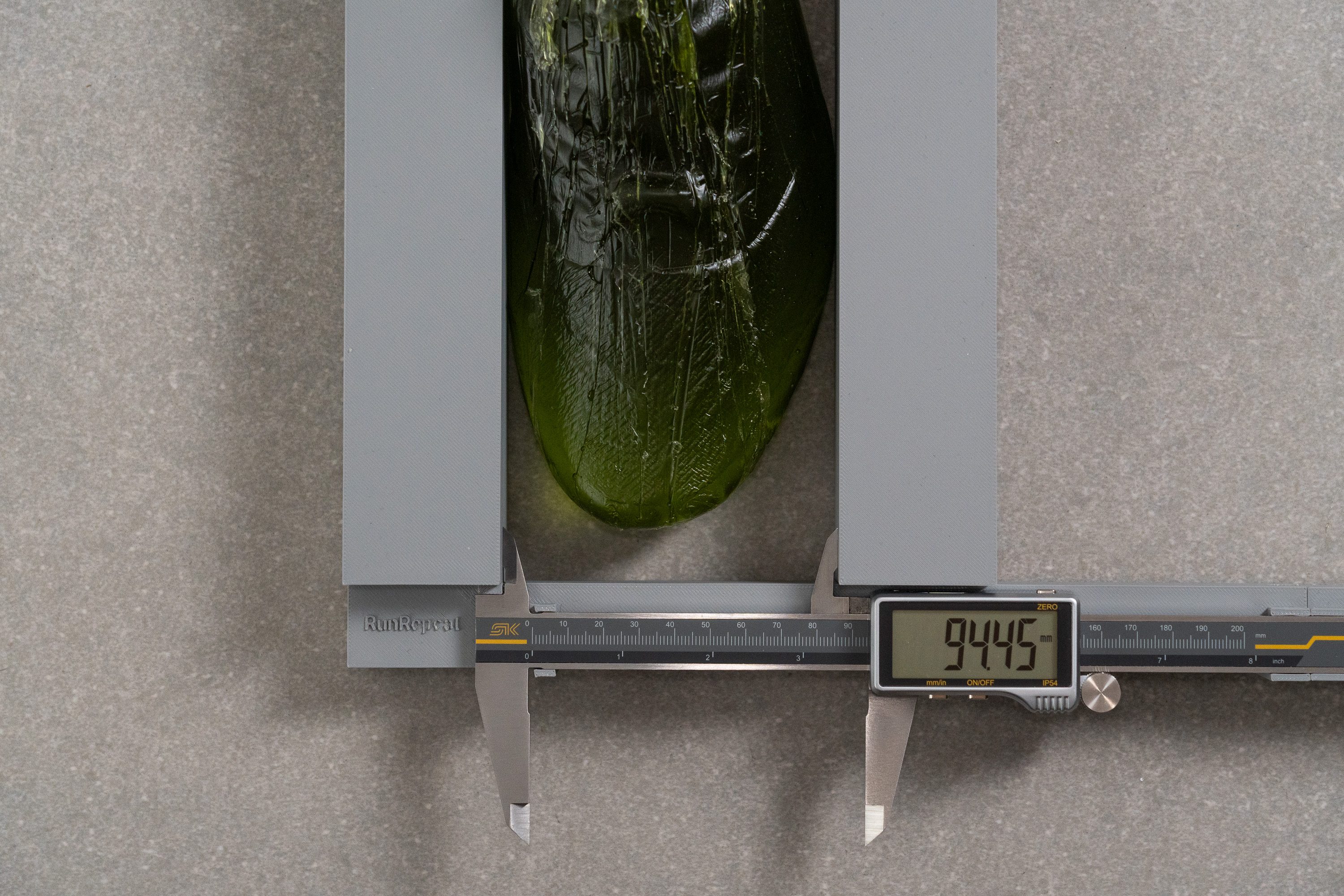
| GT 2000 14 | 94.5 mm |
| Media | 95.1 mm |
Anchura de la parte delantera
Cuando analizamos la parte delantera de este modelo, vimos que era bastante estrecha, de 68,4 mm. Vamos, que no va a ser la mejor opción para todos los corredores, y mucho menos para los que tienen pies anchos.
Por suerte, ASICS también fabrica este modelo en una versión ancha, aunque su disponibilidad varía según el país.
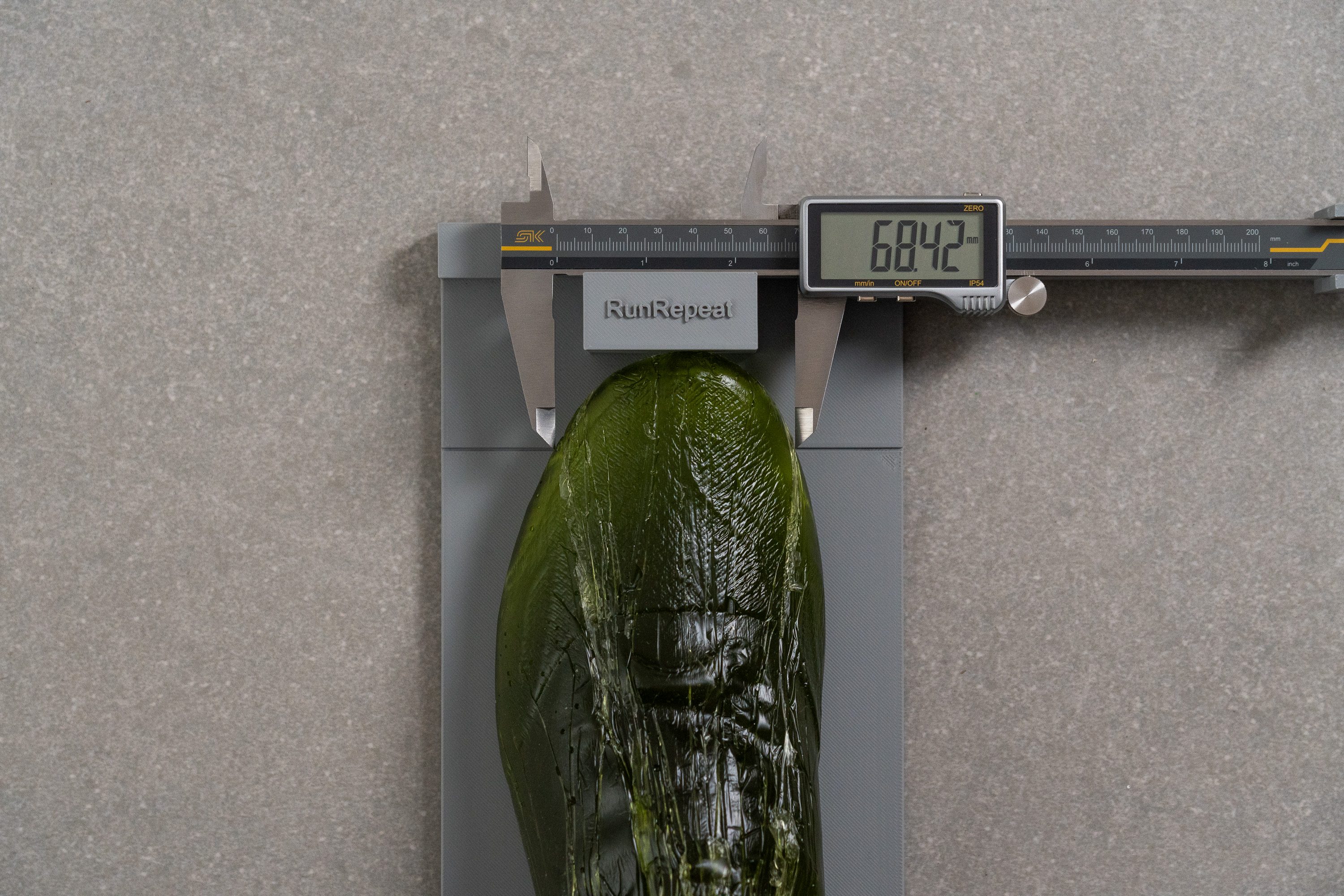
| GT 2000 14 | 68.4 mm |
| Media | 73.2 mm |
Altura de la parte delantera
Cuando analizamos la altura de la parte delantera, nos encontramos con otro resultado bajo de solo 24,9 mm.
En nuestra opinión, este factor es muy limitante, lo que hace que las GT 2000 14 sean más adecuadas para las personas con pies estrechos y de poco volumen.
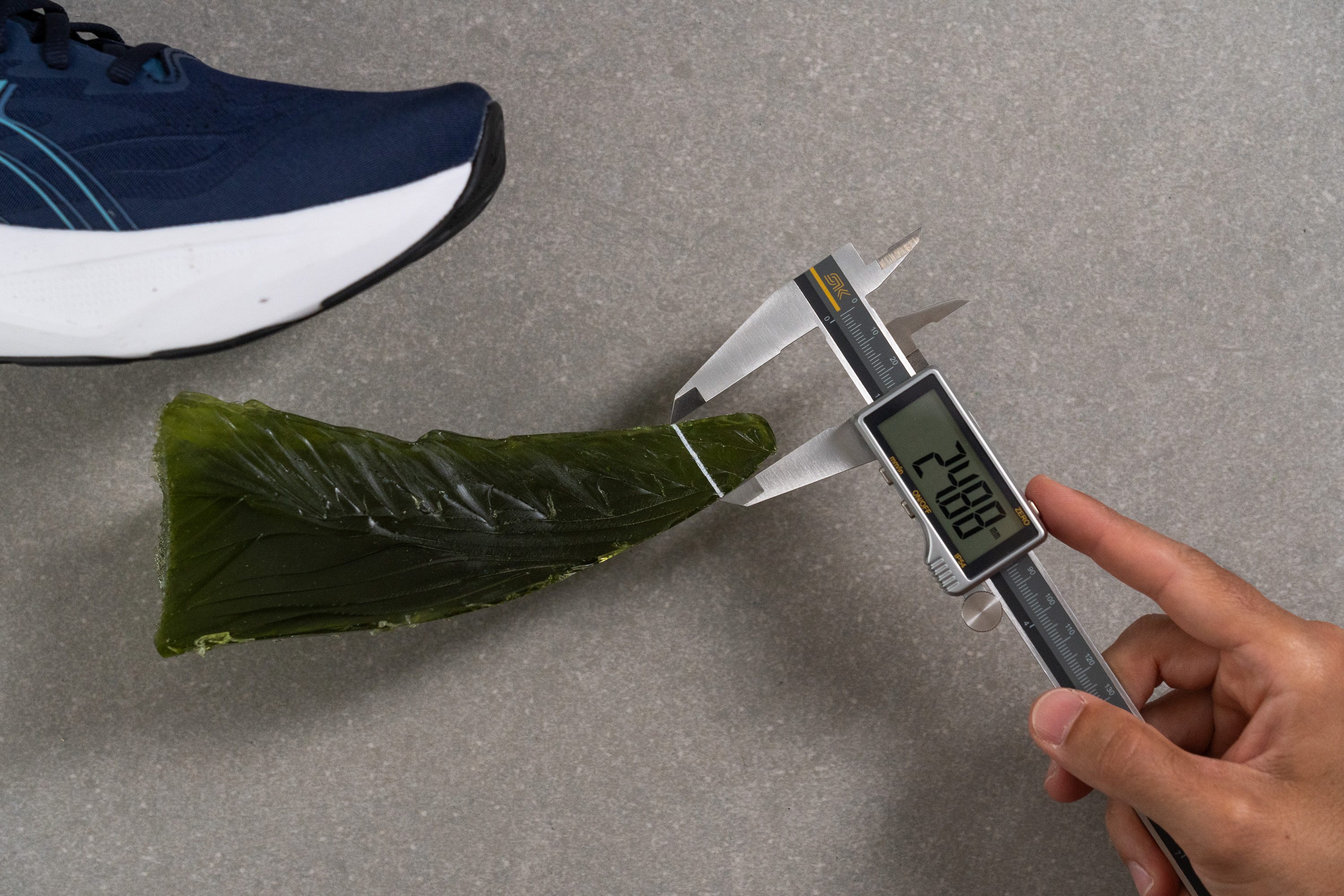
| GT 2000 14 | 24.9 mm |
| Media | 27.1 mm |
Tracción / Agarre
Traction test
Aunque la mediasuela subió de nivel al tener la espuma FF Blast Max, la suela exterior sigue teniendo el caucho AHAR, combinando AHAR+ y AHAR LO pero dejando fuera el ASICSGRIP, que ya hemos analizado en otros modelos como las Superblast 2 y nos pareció increíble.
Incluso así, en nuestra prueba de tracción se llevó un 0,47, ofreciendo un agarre sólido en hormigón mojado, asfalto seco o incluso caminos de tierra. Mira, de hecho, aunque ASICS rediseñó la suela exterior, se llevó el mismo resultado en esta prueba.
| GT 2000 14 | 0.47 |
| Media | 0.48 |
Diseño de la suela exterior
La suela exterior de las GT 2000 14 está hecha con un caucho grueso separado en cápsulas segmentadas por el antepié y el talón. Los tacos de caucho tienen un diseño en forma de llama, y la parte delantera tiene una cápsula central parecida a la que vemos en la serie Novablast.
En comparación con las GT 2000 13, que tenían una cobertura de caucho mucho más uniforme y en forma de bloques, la v14 introduce un diseño más moderno con cortes más profundos y un caucho menos continuo. Sin embargo, la cobertura de la cara interna sigue siendo importante, que es algo que les va como anillo al dedo a los pronadores.
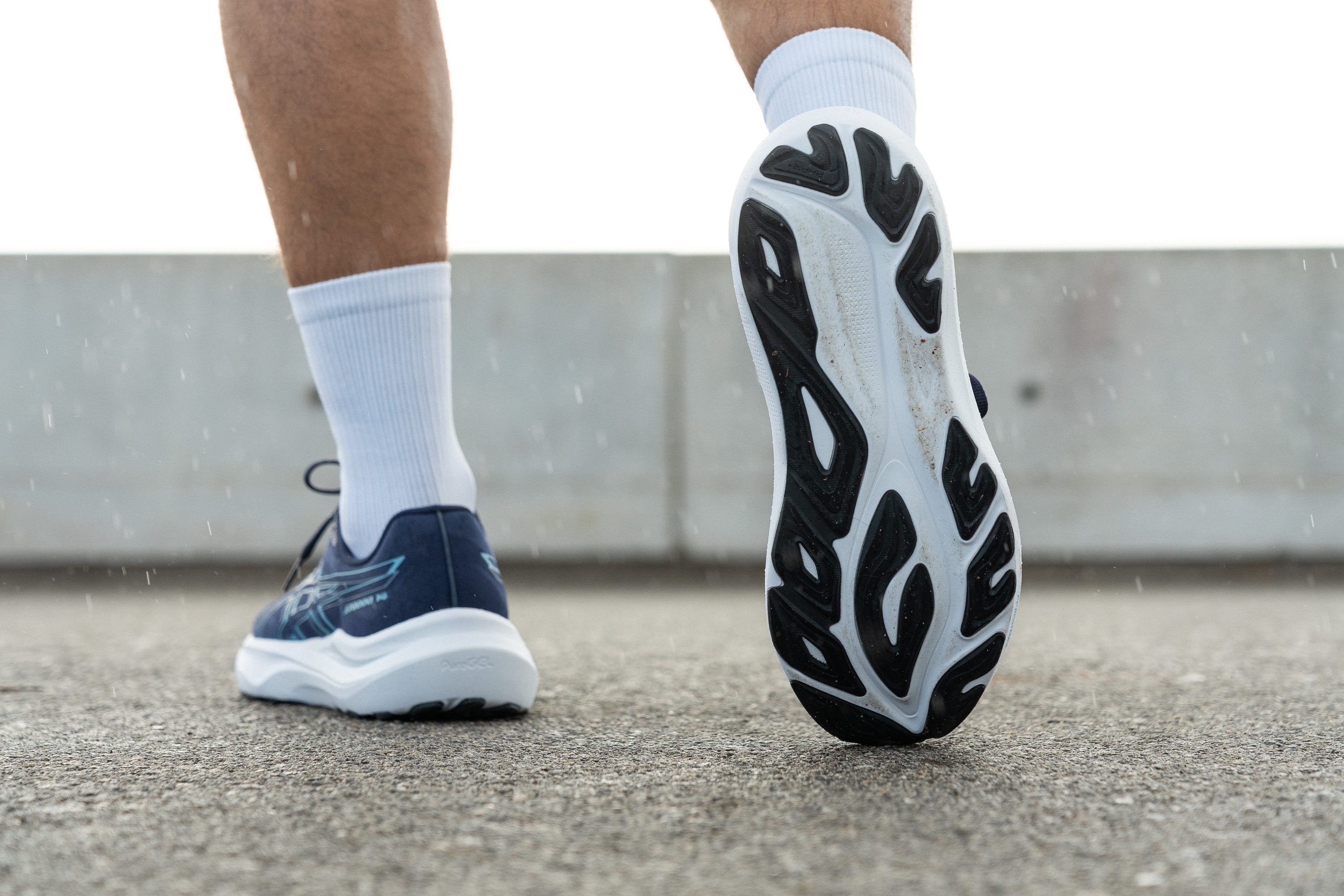
Flexibilidad / Rigidez
La flexibilidad sigue siendo estándar con sus 15,0 N, que es algo que nos esperábamos de una mediasuela de altura moderada que está diseñada para controlar la pronación. Creemos que es una ventaja, ya que las GT 2000 14 buscan desaparecer bajo el pie y, simplemente, cumplir con su función.
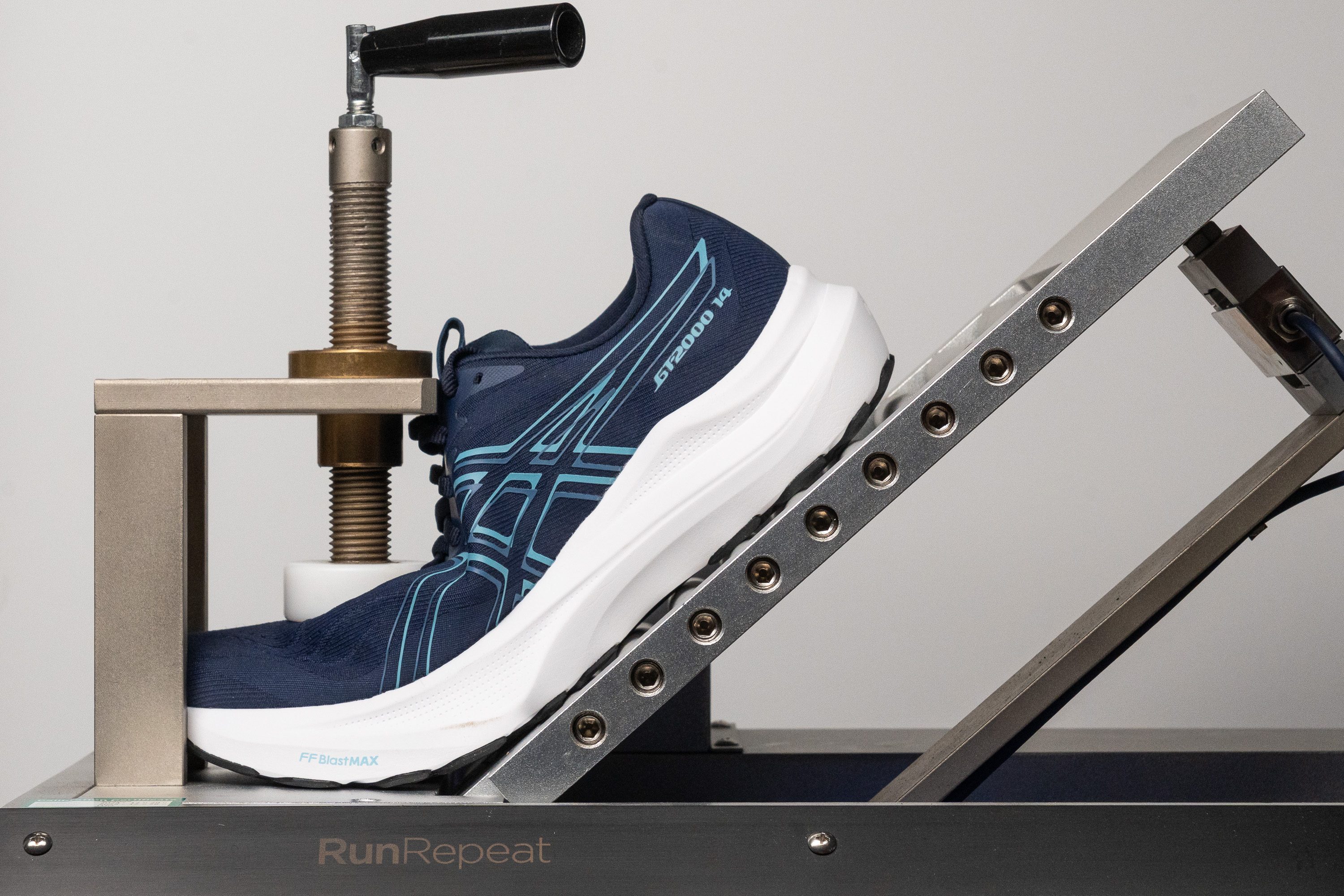
| GT 2000 14 | 15.0N |
| Media | 15.3N |
Peso
Este modelo pesa un poco más que la v13, pero este incremento del 2 % casi no se siente al caminar. Nuestra báscula marcó 269 g, que sigue siendo muy razonable para unas zapatillas de estabilidad.
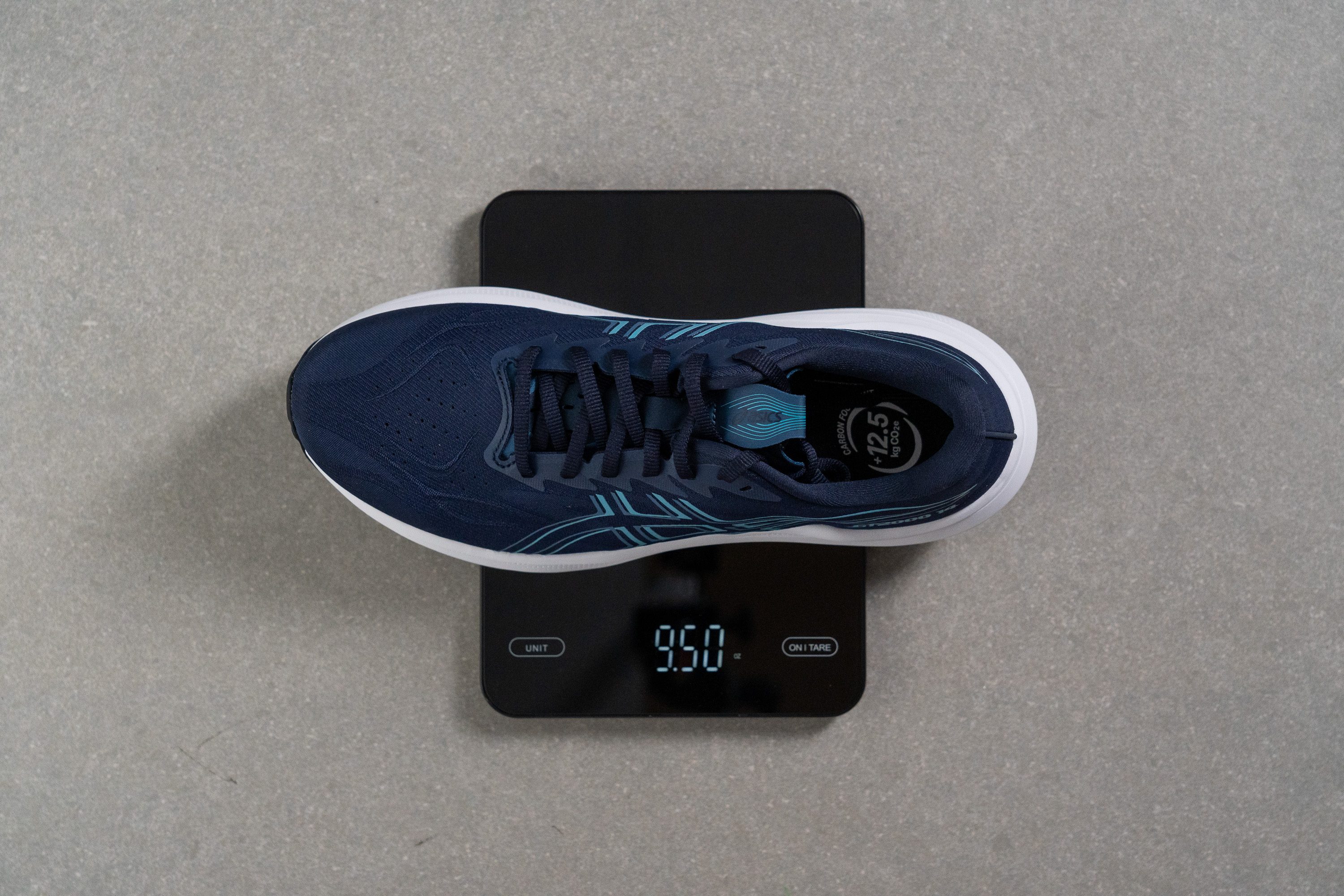
| GT 2000 14 | 9.5 oz (269g) |
| Media | 9.3 oz (264g) |
Transpirabilidad
Las GT 2000 14 se llevaron solo un 2/5 en nuestra prueba de transpirabilidad, que es bastante menos que el 4/5 que obtuvo la versión anterior. El flujo de aire está restringido, lo que puede ser incómodo en los días en los que hace calor; por otro lado, estas zapatillas son muy calentitas para cuando empieza a hacer fresquito.
A ver, aunque ASICS les puso agujeritos de ventilación en la parte delantera, el resto del upper está diseñado para proporcionar estabilidad. Tiene una malla más gruesa que contiene mejor las fuerzas laterales, pero también atrapa el calor dentro de las zapatillas.
Cuando le echamos un ojo al upper bajo el microscopio, descubrimos una malla técnica densa con ojales redondos perforados.
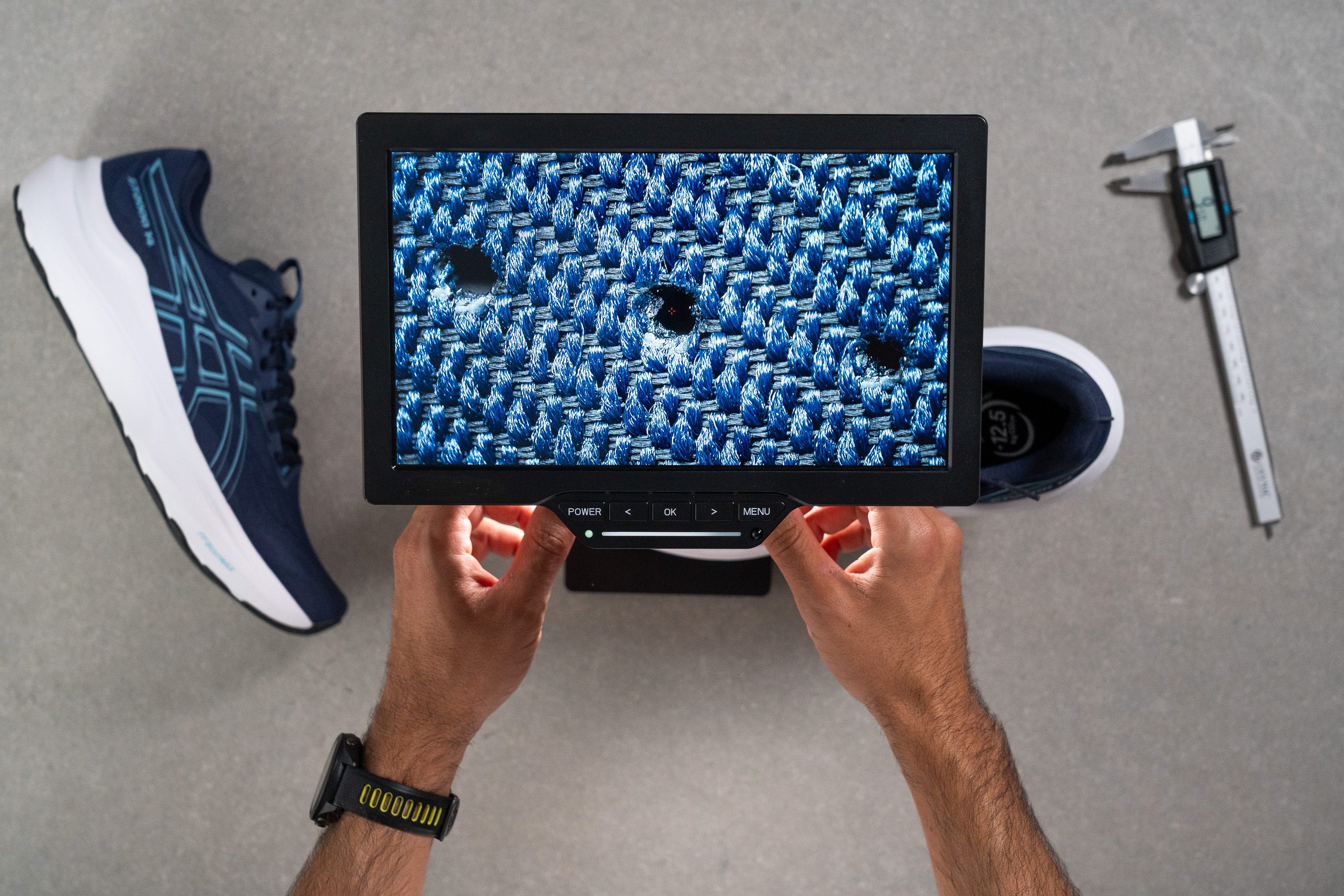
La verdad es que es un diseño inusual en comparación con lo que normalmente vemos en el laboratorio. El upper está diseñado con hilos sintéticos multifilamento colocados en una cuadrícula compacta. A diferencia de los diseños tradicionales de malla técnica, esta estructura prioriza la sujeción.
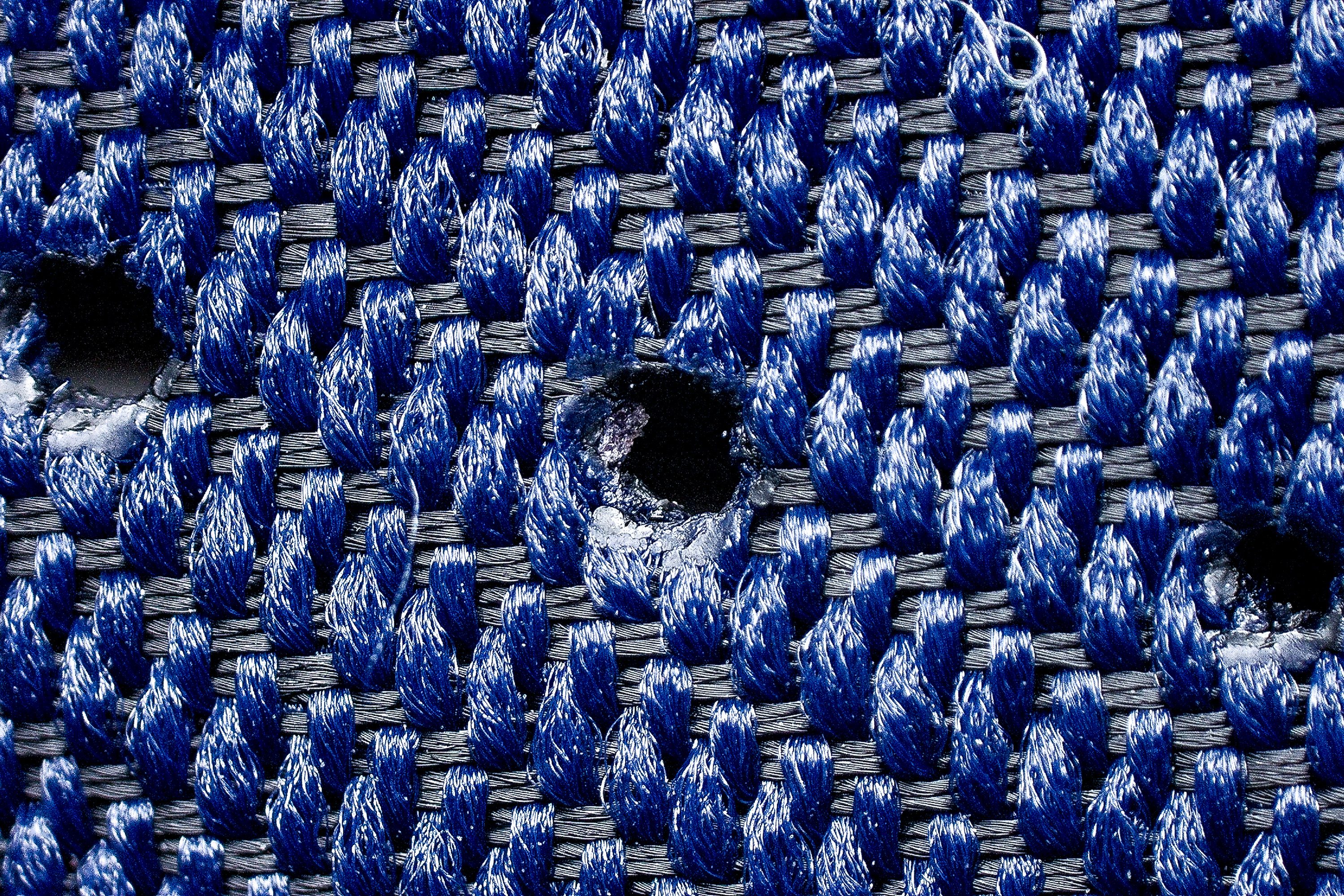
El upper está muy bien diseñado, ya que tiene una cantidad adecuada de acolchado para su peso y se ajusta al rango de precios de estas zapatillas. Pero bueno, la verdad es que nos gustaría que su flujo de aire fuese más eficiente.
| GT 2000 14 | 2 |
| Media | 3.7 |
Estabilidad
Prueba de estabilidad lateral
La estabilidad lateral de las GT 2000 14 es uno de sus puntos fuertes principales.
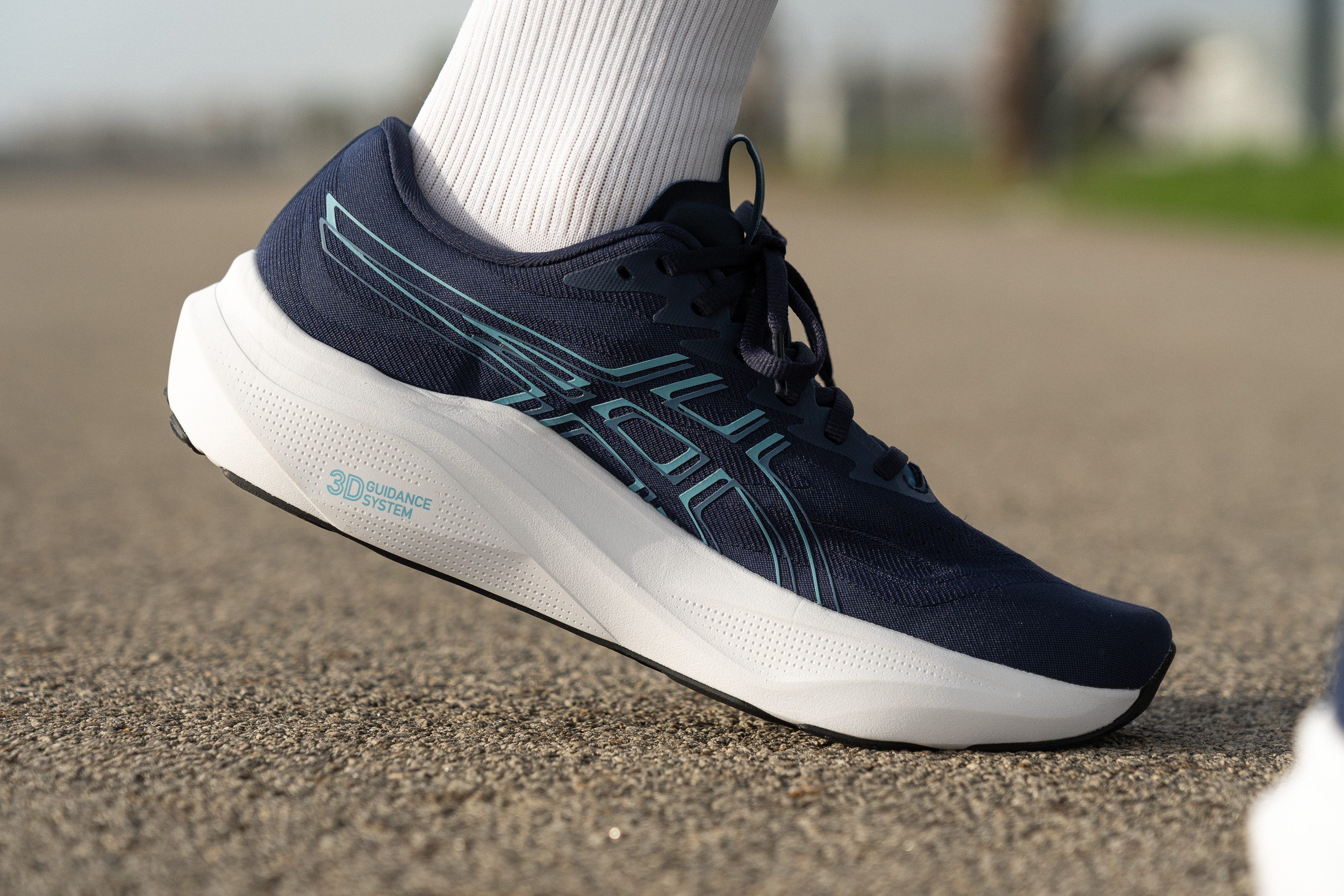
Mantienen la tecnología 3D Guidance System de la versión anterior, que en vez de tener un arco más firme, utiliza una base más amplia, una geometría de la mediasuela que controla la pronación y paredes de la mediasuela altas en el mediopié para ofrecer sujeción.
Rigidez torsional
Hay un cambio chiquitito que viene, directamente, del nuevo diseño de la suela exterior: una estructura más flexible.
La versión 13 se llevó un 5/5 en nuestra prueba de rigidez, así que a lo mejor era un poquito demasiado para un modelo de entrenamiento diario versátil. El 4/5 que obtuvo esta nueva versión nos parece más práctico, ya que hace que estas zapatillas sean más cómodas para correr a ritmos suaves o incluso para caminar.
| GT 2000 14 | 4 |
| Media | 3.5 |
Rigidez del contrafuerte del talón
Por otro lado, ASICS decidió no cambiar la rigidez del contrafuerte del talón. El de este modelo se llevó otro 4/5 en nuestra prueba, igual que la versión v12 y la v13, y estamos muy contentos con ese resultado.
| GT 2000 14 | 4 |
| Media | 2.9 |
Anchura de la mediasuela - antepié
Una de las características distintivas de la serie GT 2000 es su capacidad para ofrecer estabilidad sin ser voluminosa. ¿Que cómo lo consigue ASICS? Pues sin utilizar una mediasuela altísima y manteniendo un diseño compacto que sigue los estándares modernos.
Cuando la medimos, nuestro calibre marcó 117,6 mm en el antepié. Este resultado, que es un poco más alto que la media, está justo entre las proporciones de un modelo de entrenamiento diario neutro y unas zapatillas de estabilidad propiamente dichas, que tienen una estructura más amplia.
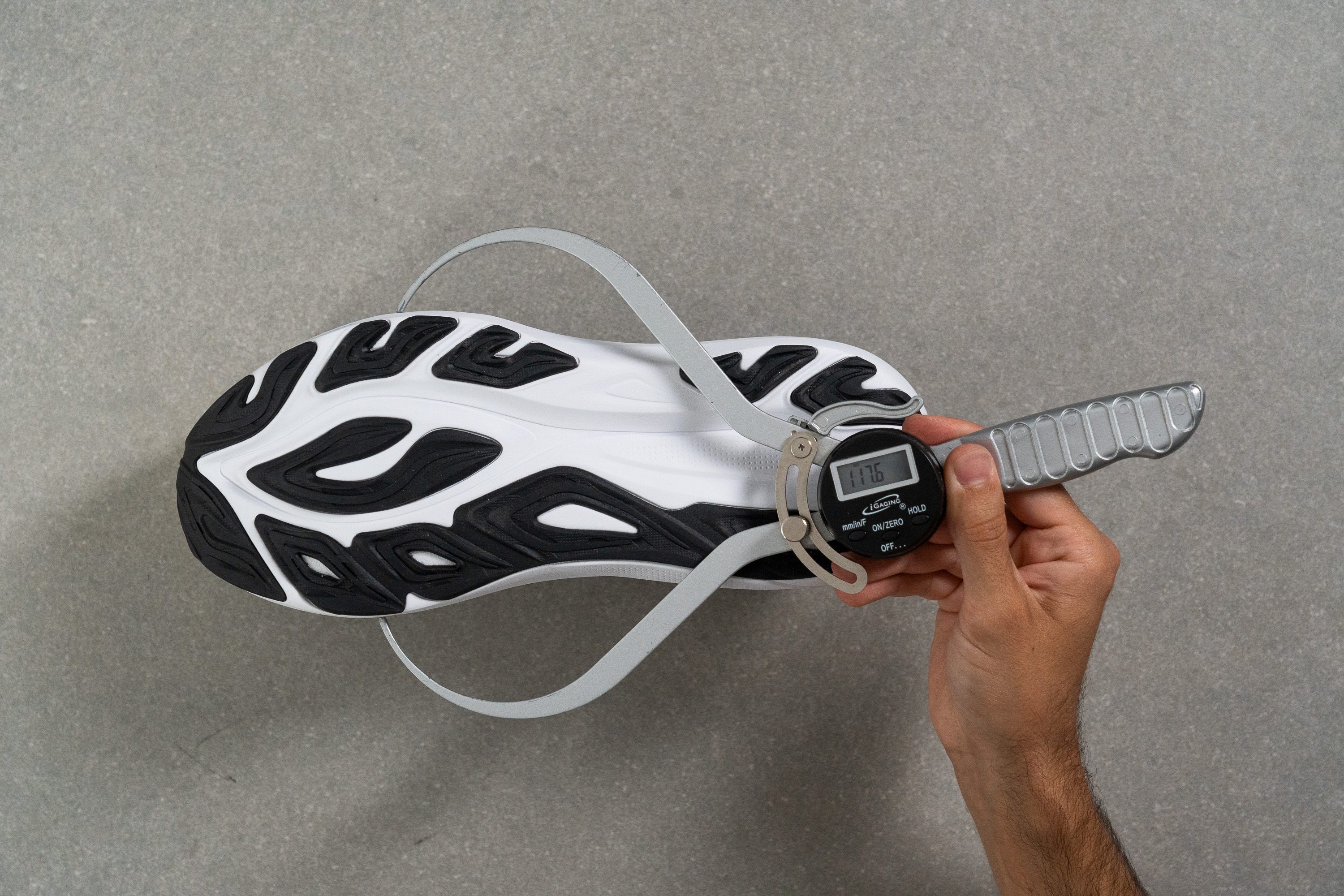
| GT 2000 14 | 117.6 mm |
| Media | 114.4 mm |
Anchura de la mediasuela - talón
El talón es un poco más ancho en comparación, pero la verdad es que eso nos tiene todo el sentido del mundo, ya que es más complicado conseguir estabilidad en el talón que en el antepié.
ASICS dio un paso atrás con respecto al modelo del año pasado, ya que la anchura en esta zona ahora es de 97,1 mm, y no de 102,2 mm como en las v13 (que era un poco excesivo para unas zapatillas de estabilidad moderada como estas).
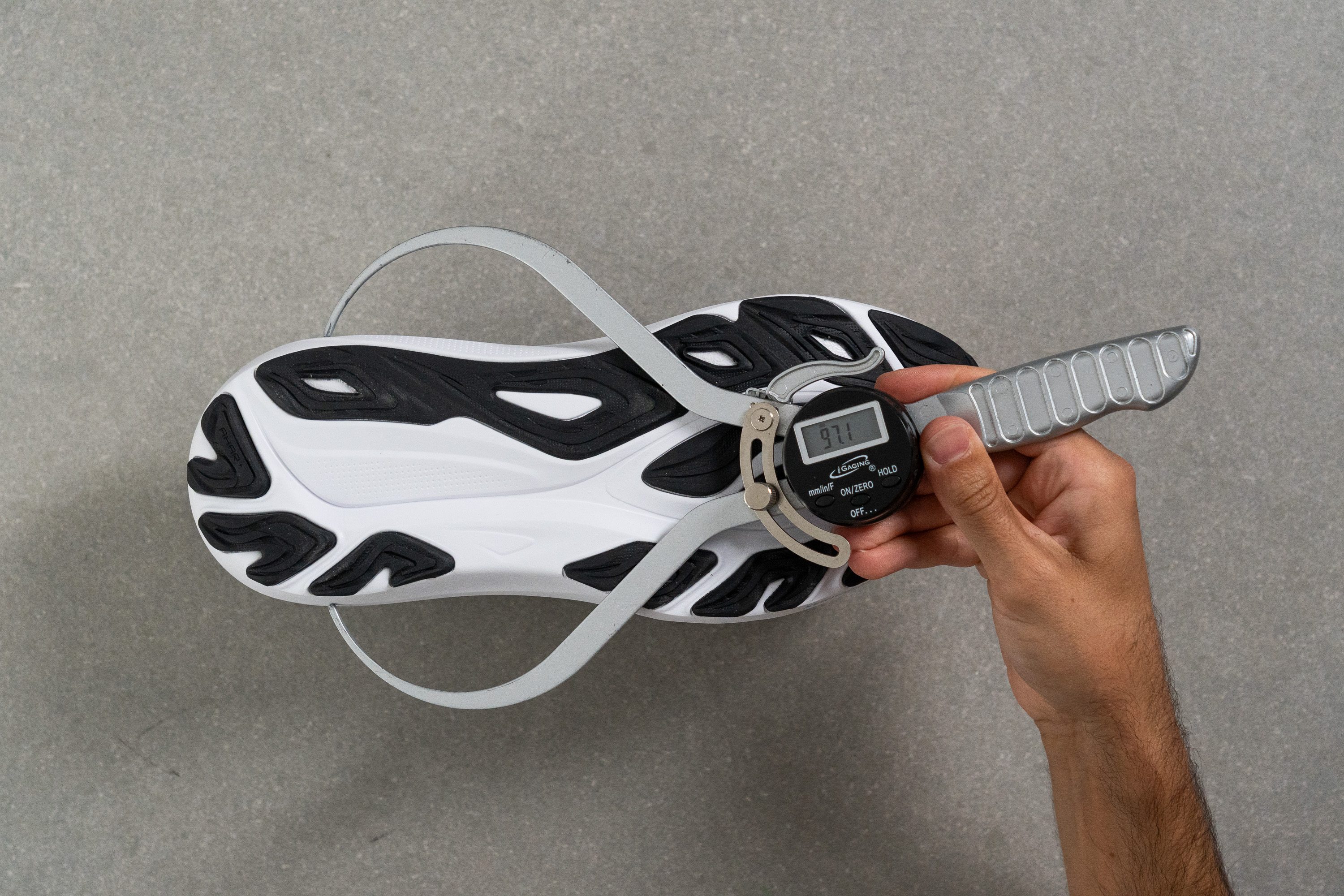
| GT 2000 14 | 97.1 mm |
| Media | 90.7 mm |
Durabilidad
Durabilidad de la parte delantera
Como su transpirabilidad deja tanto que desear, teníamos la esperanza de que se llevasen una puntuación mucho más alta que el 2/5 que tuvimos que darles en nuestra prueba de durabilidad. ASICS, creemos que tienes que mejorar bastante en este aspecto.
| GT 2000 14 | 2 |
| Media | 2.6 |
Durabilidad del acolchado del talón
Por otro lado, el acolchado del talón se llevó un resultado mucho mejor en nuestra prueba de durabilidad: un 4/5. Para los corredores que suelen desgastar esta zona, las GT 2000 14 son una opción fiable.
| GT 2000 14 | 4 |
| Media | 3.4 |
Durabilidad de la suela
Para muchos corredores con pronación, la verdadera prueba de durabilidad siempre es la de la suela exterior.
Y en nuestro laboratorio, comprobamos que las GT 2000 14 la superaron con creces. Los daños fueron de solo 0,5 mm por mucha caña que les metimos, así que esta suela está, claramente, hecha para resistir el desgaste.
| GT 2000 14 | 0.5 mm |
| Media | 1.1 mm |
Grosor de la suela
Creemos que ASICS diseñó la suela exterior de las GT 2000 14 para que dure casi para siempre. Además de su alta resistencia a la abrasión, resulta que tiene un grosor considerable de 4,0 mm, superando a la mayoría de las zapatillas de estabilidad.
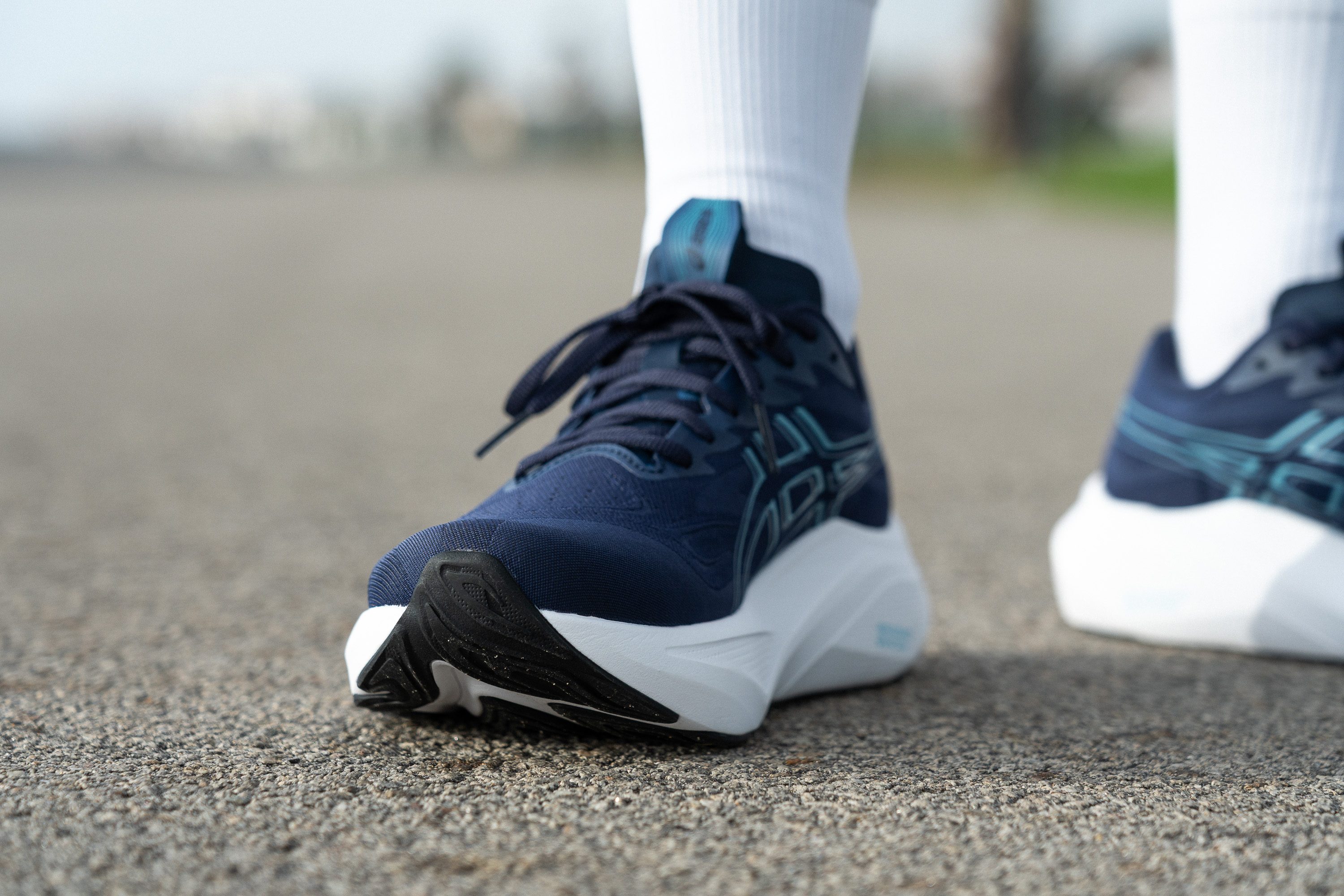
Según los resultados de nuestras pruebas de uso, es casi hasta demasiado. Esto es ideal para los runners que se centran en la durabilidad pero, para los demás, una capa más finita podría haber hecho que la experiencia fuese más dinámica, a la vez que se reduciría el peso.
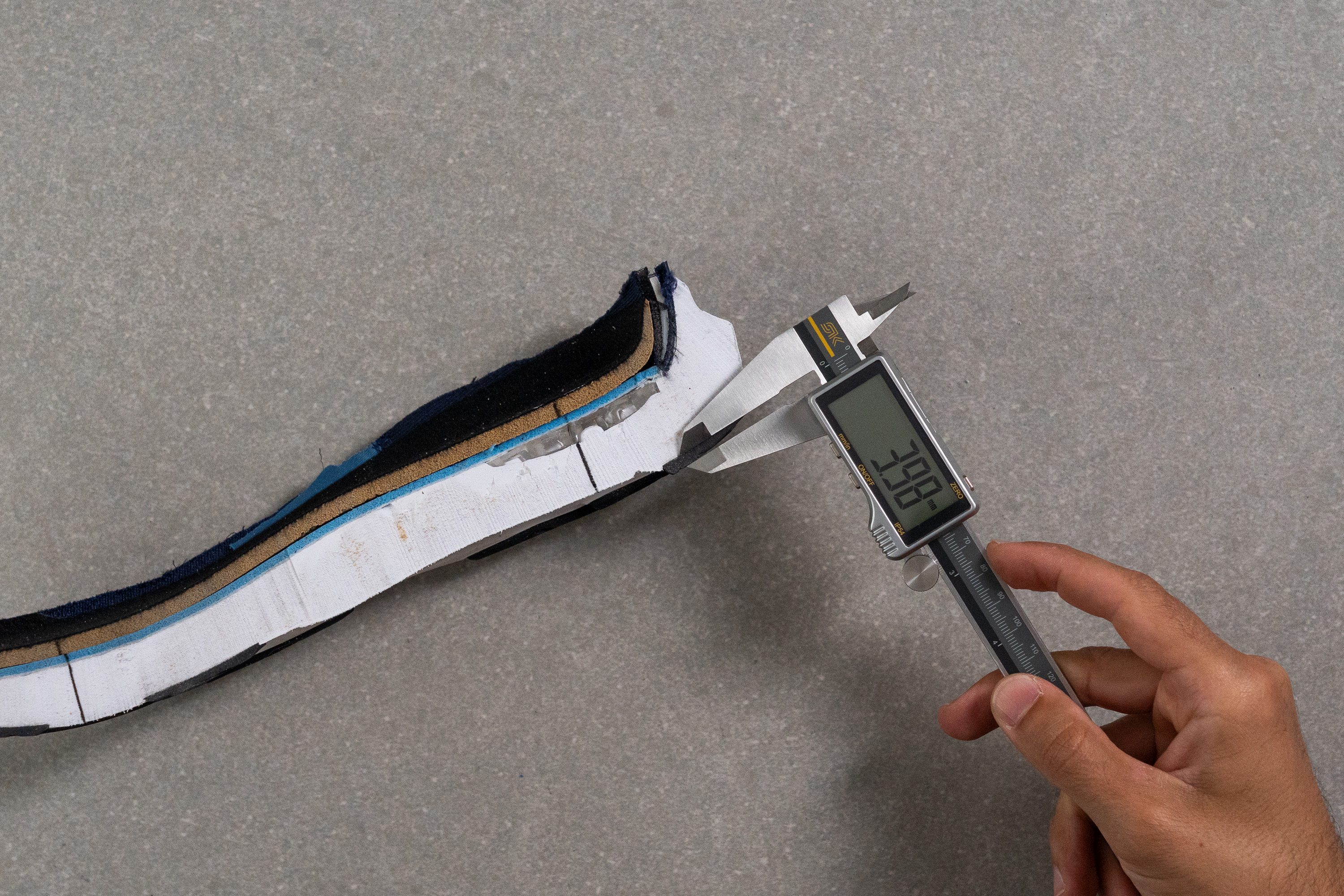
| GT 2000 14 | 4.0 mm |
| Media | 3.2 mm |
Varios
Grosor de la plantilla
La plantilla es una pieza estándar de EVA con un diseño sencillo y un grosor de 4,7 mm.
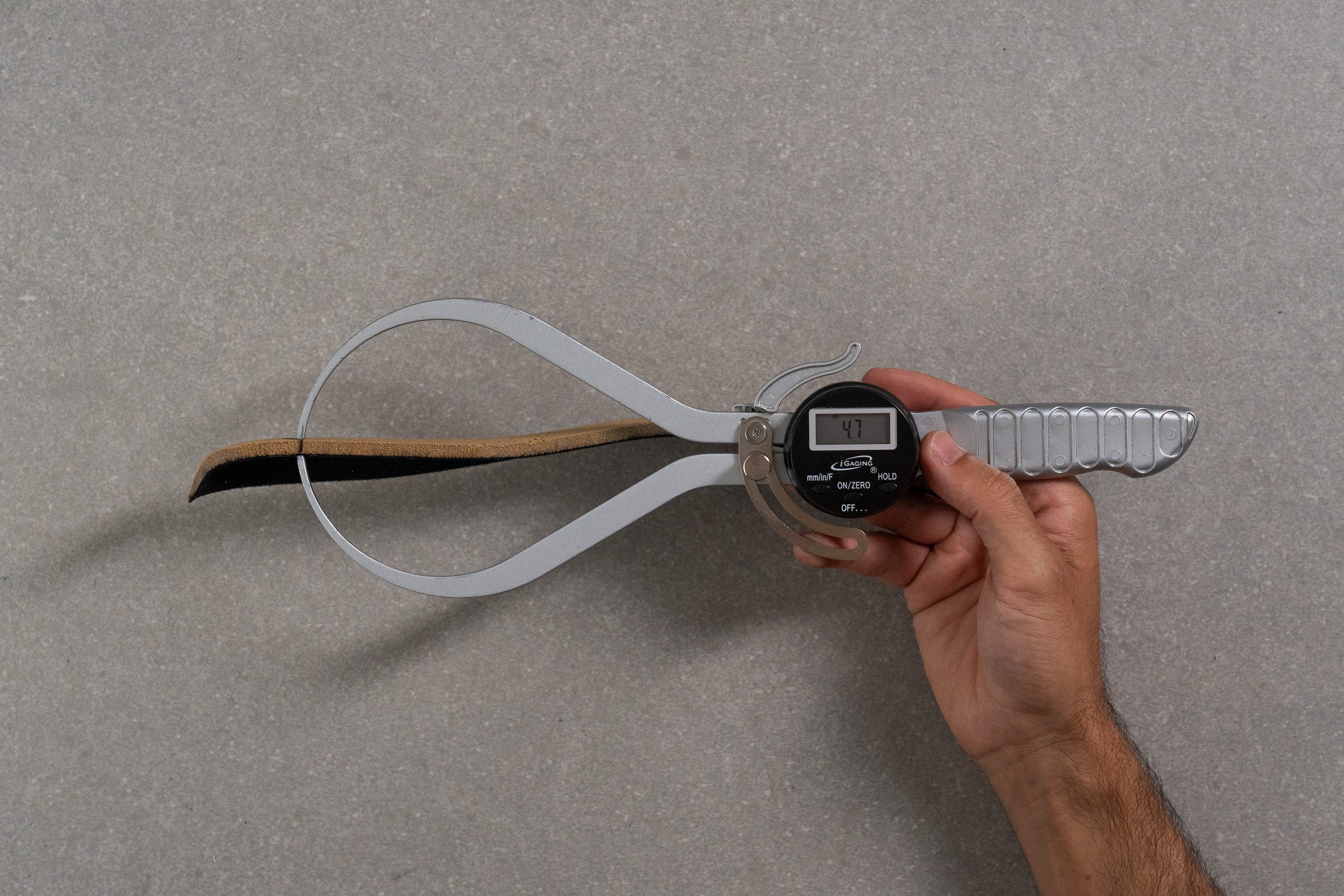
| GT 2000 14 | 4.7 mm |
| Media | 4.5 mm |
Plantilla extraíble
Puedes quitársela sin problema a las zapatillas, ya que no está pegada a la base. Además, gracias a su forma, la mayoría de las opciones del mercado se adaptarán sin ningún problema.
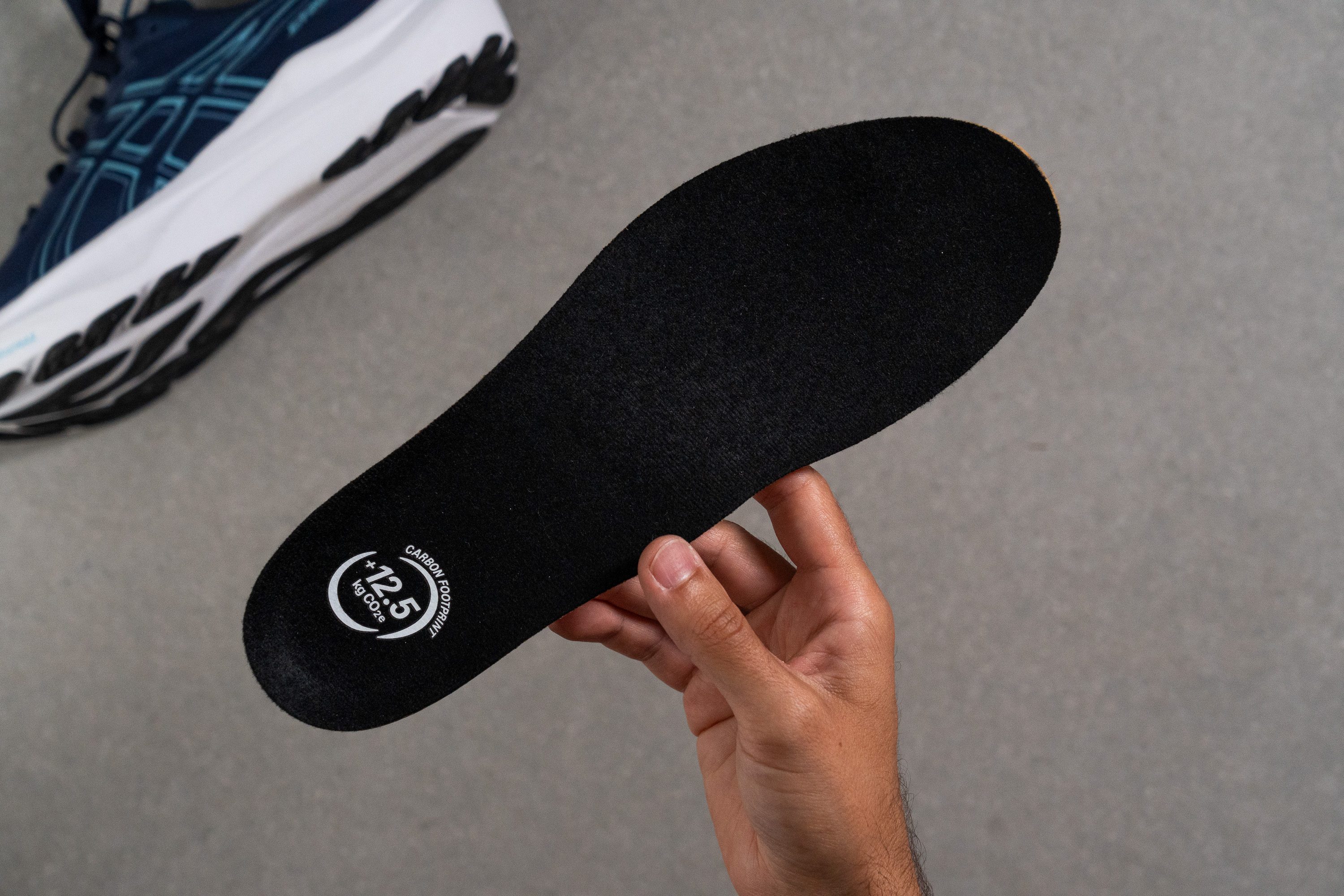
| GT 2000 14 | Sí |
Rigidez de la mediasuela en frío (%)
La espuma FF Blast Max se volvió bastante más rígida con el frío. Después de meter las zapatillas 20 minutos en el congelador, nuestro durómetro marcó 24,0 HA, lo que representa un incremento del 38 % en comparación con el resultado a temperatura ambiente.
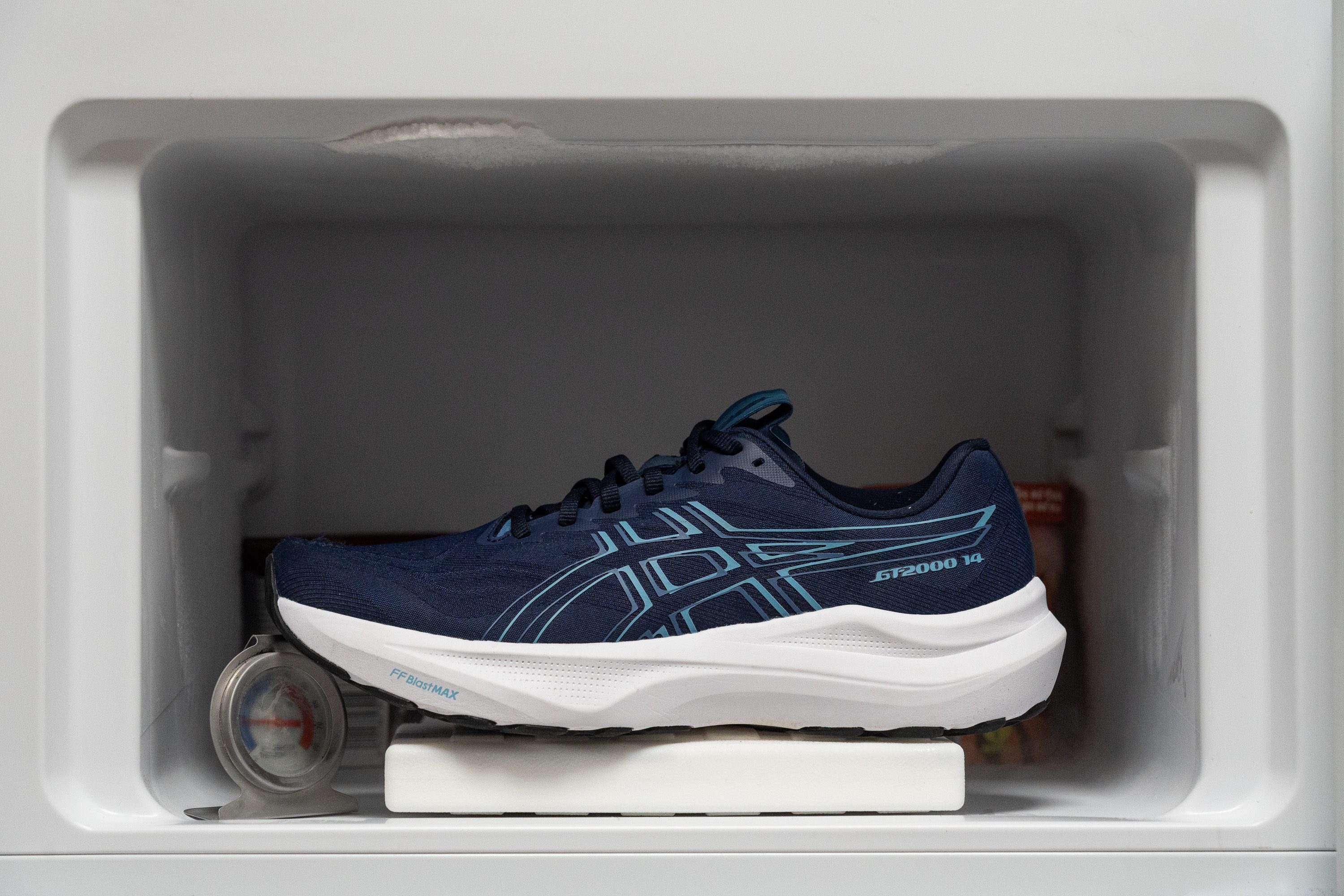
| GT 2000 14 | 38% |
| Media | 24% |
Elementos reflectantes
Un detalle que sí que nos gustaría que fuera diferente es que no tienen elementos reflectantes. A lo mejor esto no les importa a muchos corredores, pero es que siempre es una ventaja para la visibilidad y, al fin y al cabo, tampoco tiene ningún inconveniente.
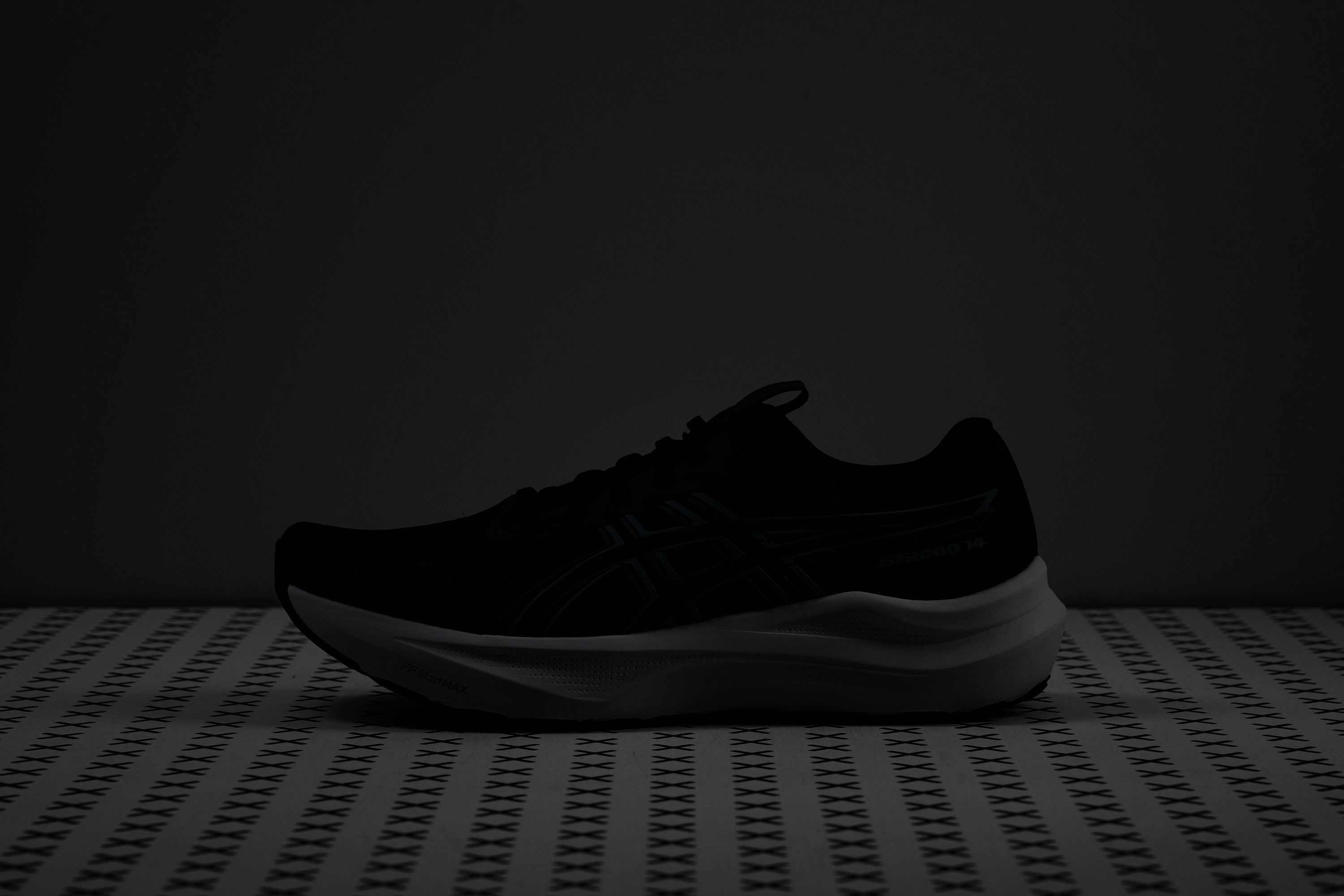
| GT 2000 14 | No |
Acolchado de la lengüeta
Las GT 2000 14 tienen un sistema de cordones sencillo con 6 ojales a cada lado, además de 1 ojal extra en la parte de arriba para que te puedas hacer el nudo del corredor. Todos los ojales están perforados directamente en la malla técnica, pero ASICS los reforzó con superposiciones para mejorar la durabilidad.
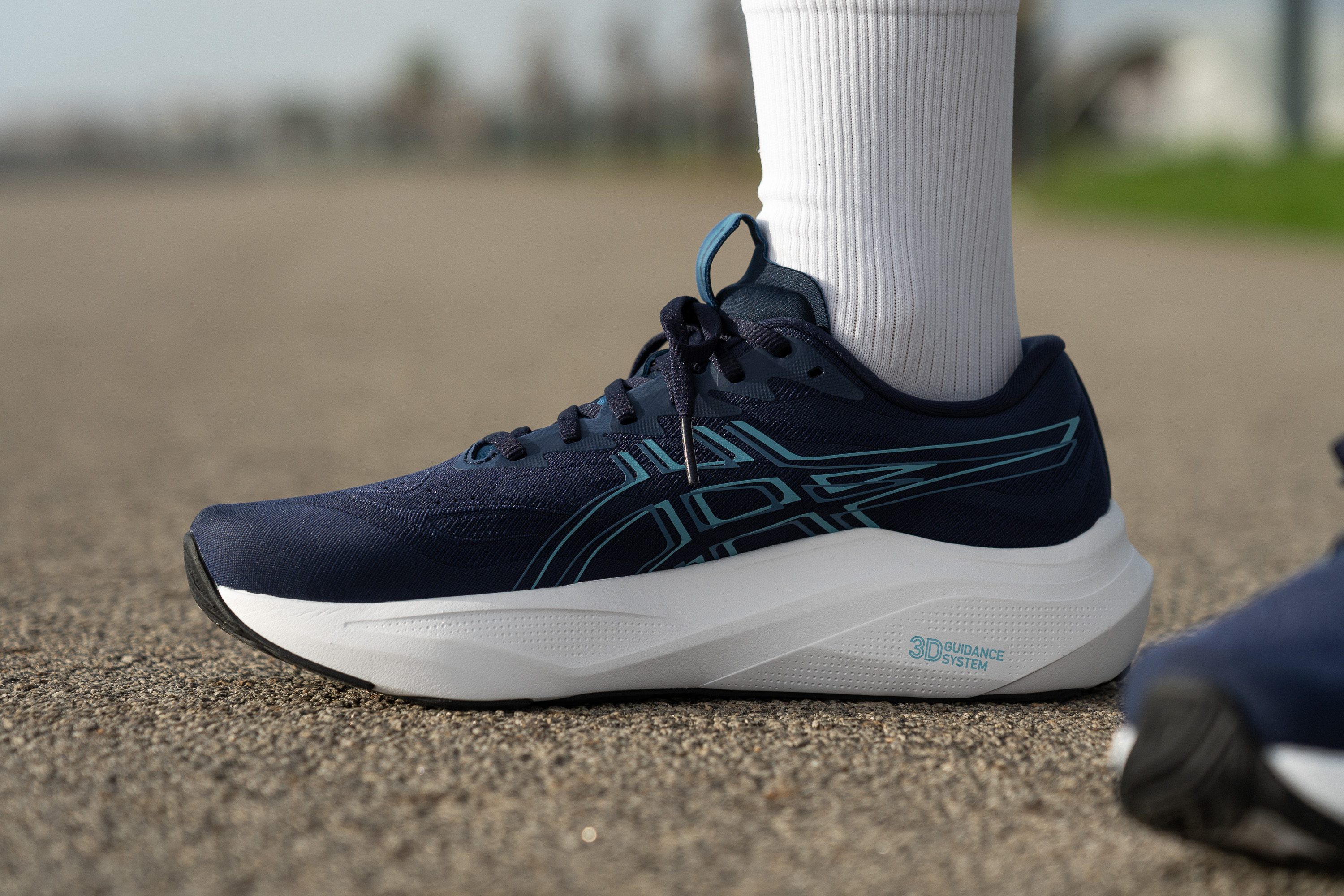
Cuando medimos la lengüeta, descubrimos que alcanza 6,1 mm, así que está bien acolchada pero se mantiene ligera. ASICS se centró en poner espuma solo donde hay más presión, creando un diseño muy cuidado que destaca entre las lengüetas de la mayoría de las zapatillas de running.
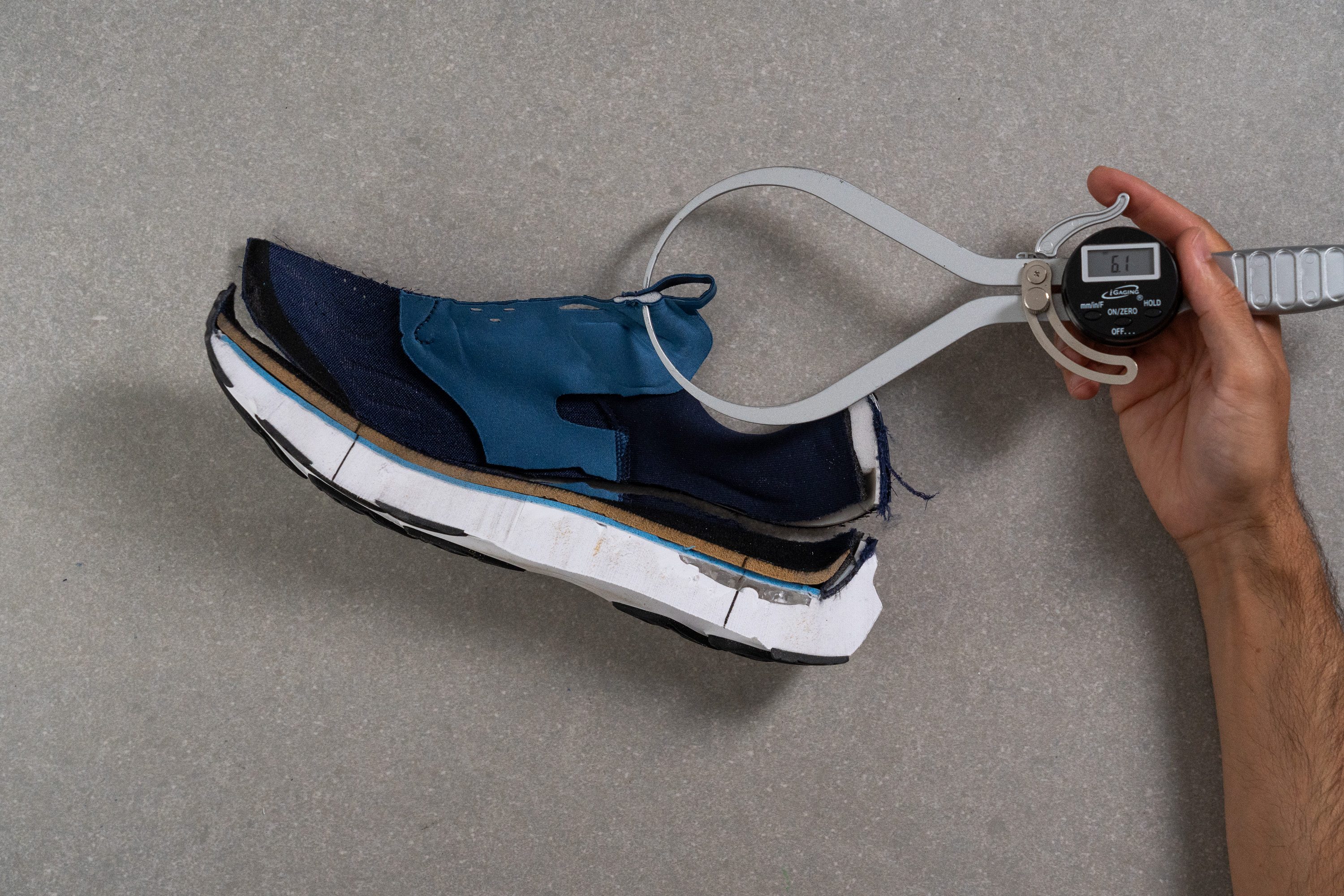
| GT 2000 14 | 6.1 mm |
| Media | 5.8 mm |
Lengüeta: tipo de refuerzo
La lengüeta de las GT 2000 14 está semi reforzada, que es un detalle maravilloso dentro de este rango de precios. Además de mejorar el ajuste, es una ventaja importante teniendo en cuenta a lo finita que es la estructura de la lengüeta; si no fuese por esta sujeción, la lengüeta podría bailar de un lado a otro.
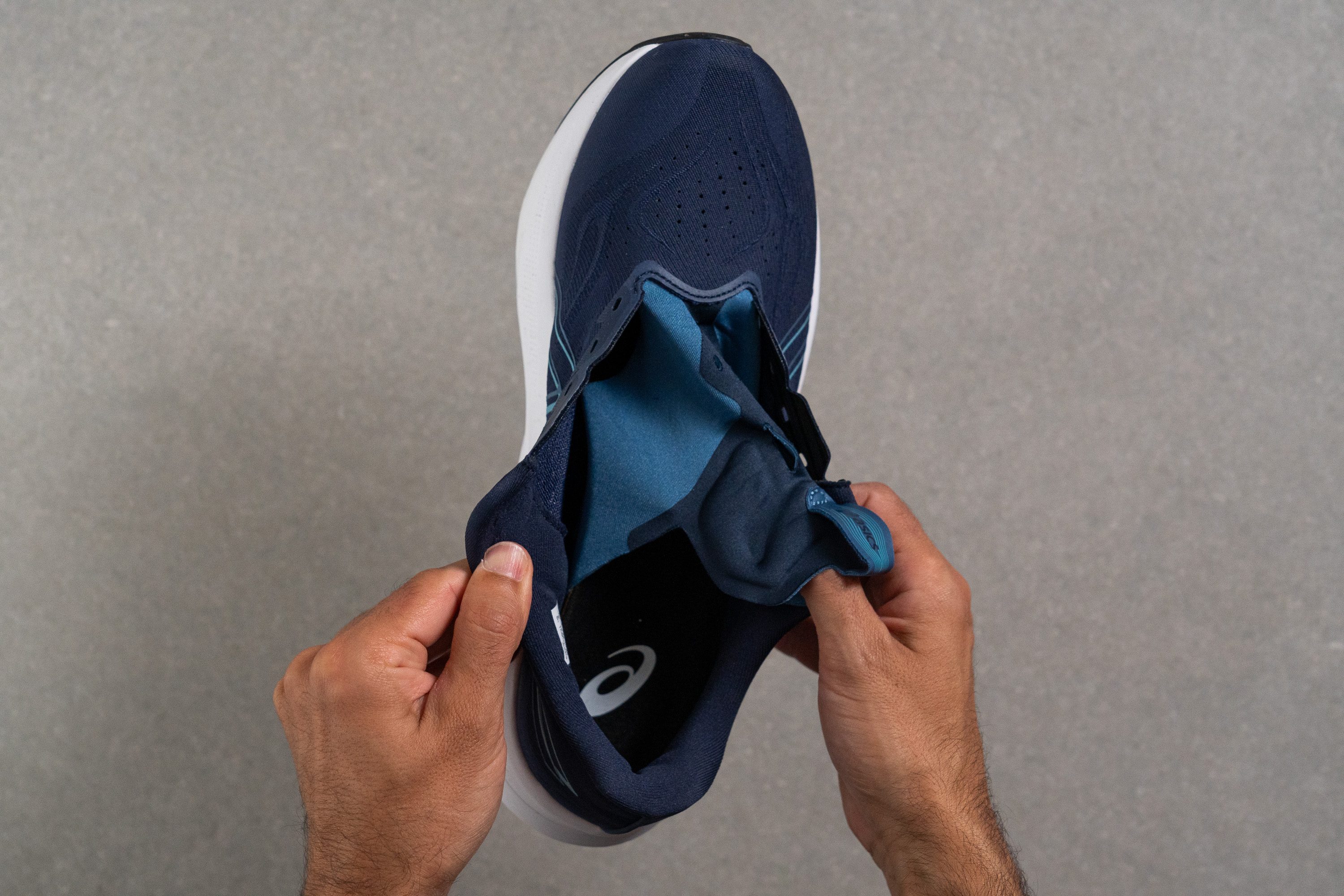
| GT 2000 14 | Ambos lados (semi) |
Precio
ASICS ha decidido darles buenas noticias a todos los corredores, ya que este modelo mantiene el mismo precio que las versiones anteriores incluso con la nueva espuma FF Blast Max. La verdad es que esto no es muy común hoy en día, ya que muchas marcas aprovechan las actualizaciones importantes para justificar un aumento de precio, como hizo Saucony con las Triumph 23.
| GT 2000 14 | $140 |
Tirador del talón
El talón de las GT 2000 14 tiene un diseño sencillo y moderno, con las costuras cuidadosamente ocultas bajo una capa. Ya no hay rastro del tirador del talón de la versión 13, y la verdad es que, en nuestra opinión, este diseño anterior era tanto más práctico como más bonito.
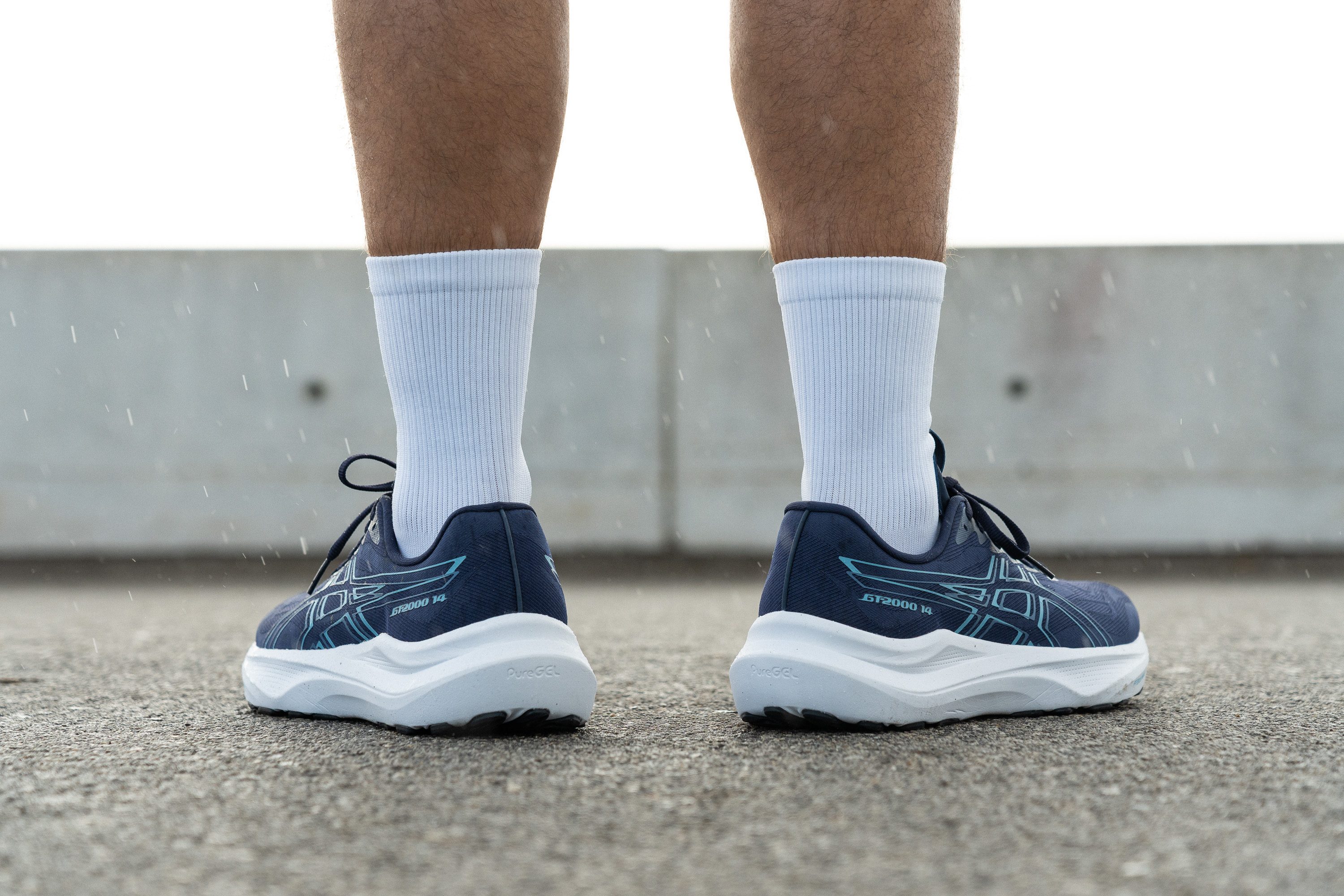
| GT 2000 14 | Ninguno |
Tirador en la lengüeta
Las GT 2000 14 tienen un lacito de tela en la lengüeta con el logo de ASICS impreso. Este tirador es un poquito alargado, así que calzarse es más fácil.
